Corporate Accounting Analysis of Myer Holding and Kathmandu Holdings Ltd
VerifiedAdded on 2023/06/04
|18
|4290
|486
AI Summary
Corporate accounting deals with the procedures related to preparation of balance sheet, comprehensive statement of profit and loss and cash flow statement. The present report revolves around analysis regarding the equity, cash flow statement, another comprehensive statement and tax expenses of Myer Holding and Kathmandu Holdings Ltd are done.
Contribute Materials
Your contribution can guide someone’s learning journey. Share your
documents today.
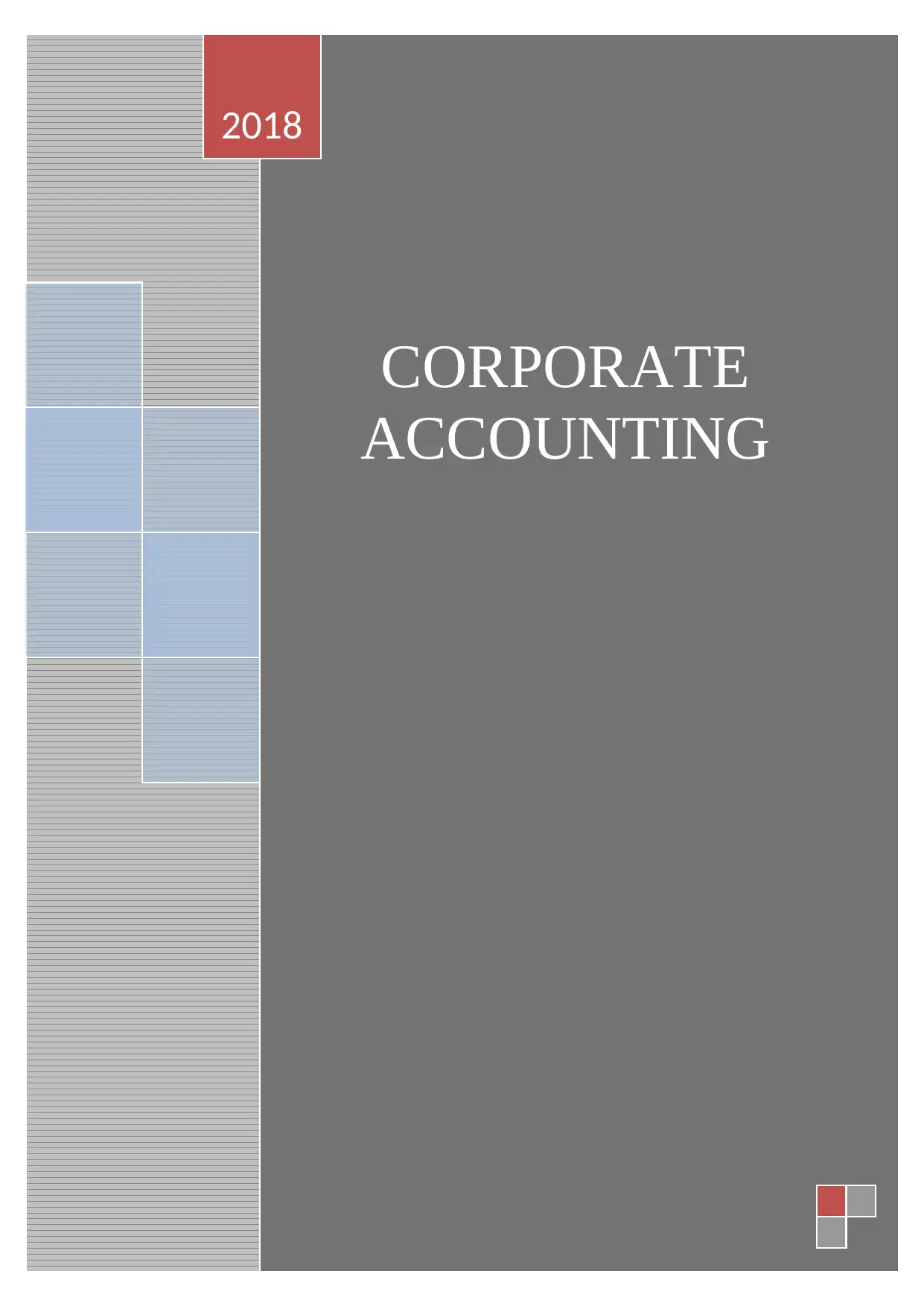
CORPORATE
ACCOUNTING
2018
ACCOUNTING
2018
Secure Best Marks with AI Grader
Need help grading? Try our AI Grader for instant feedback on your assignments.
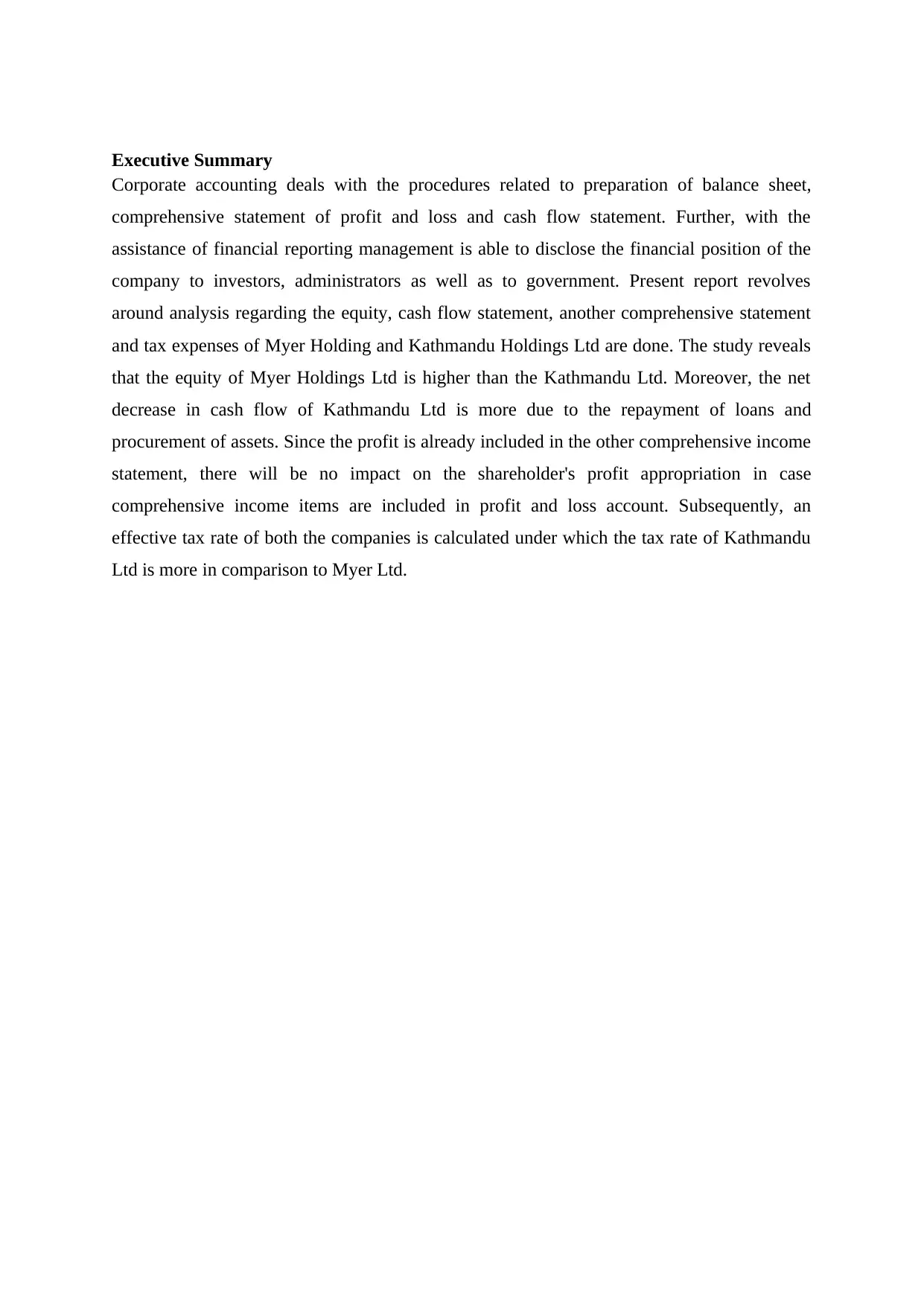
Executive Summary
Corporate accounting deals with the procedures related to preparation of balance sheet,
comprehensive statement of profit and loss and cash flow statement. Further, with the
assistance of financial reporting management is able to disclose the financial position of the
company to investors, administrators as well as to government. Present report revolves
around analysis regarding the equity, cash flow statement, another comprehensive statement
and tax expenses of Myer Holding and Kathmandu Holdings Ltd are done. The study reveals
that the equity of Myer Holdings Ltd is higher than the Kathmandu Ltd. Moreover, the net
decrease in cash flow of Kathmandu Ltd is more due to the repayment of loans and
procurement of assets. Since the profit is already included in the other comprehensive income
statement, there will be no impact on the shareholder's profit appropriation in case
comprehensive income items are included in profit and loss account. Subsequently, an
effective tax rate of both the companies is calculated under which the tax rate of Kathmandu
Ltd is more in comparison to Myer Ltd.
Corporate accounting deals with the procedures related to preparation of balance sheet,
comprehensive statement of profit and loss and cash flow statement. Further, with the
assistance of financial reporting management is able to disclose the financial position of the
company to investors, administrators as well as to government. Present report revolves
around analysis regarding the equity, cash flow statement, another comprehensive statement
and tax expenses of Myer Holding and Kathmandu Holdings Ltd are done. The study reveals
that the equity of Myer Holdings Ltd is higher than the Kathmandu Ltd. Moreover, the net
decrease in cash flow of Kathmandu Ltd is more due to the repayment of loans and
procurement of assets. Since the profit is already included in the other comprehensive income
statement, there will be no impact on the shareholder's profit appropriation in case
comprehensive income items are included in profit and loss account. Subsequently, an
effective tax rate of both the companies is calculated under which the tax rate of Kathmandu
Ltd is more in comparison to Myer Ltd.
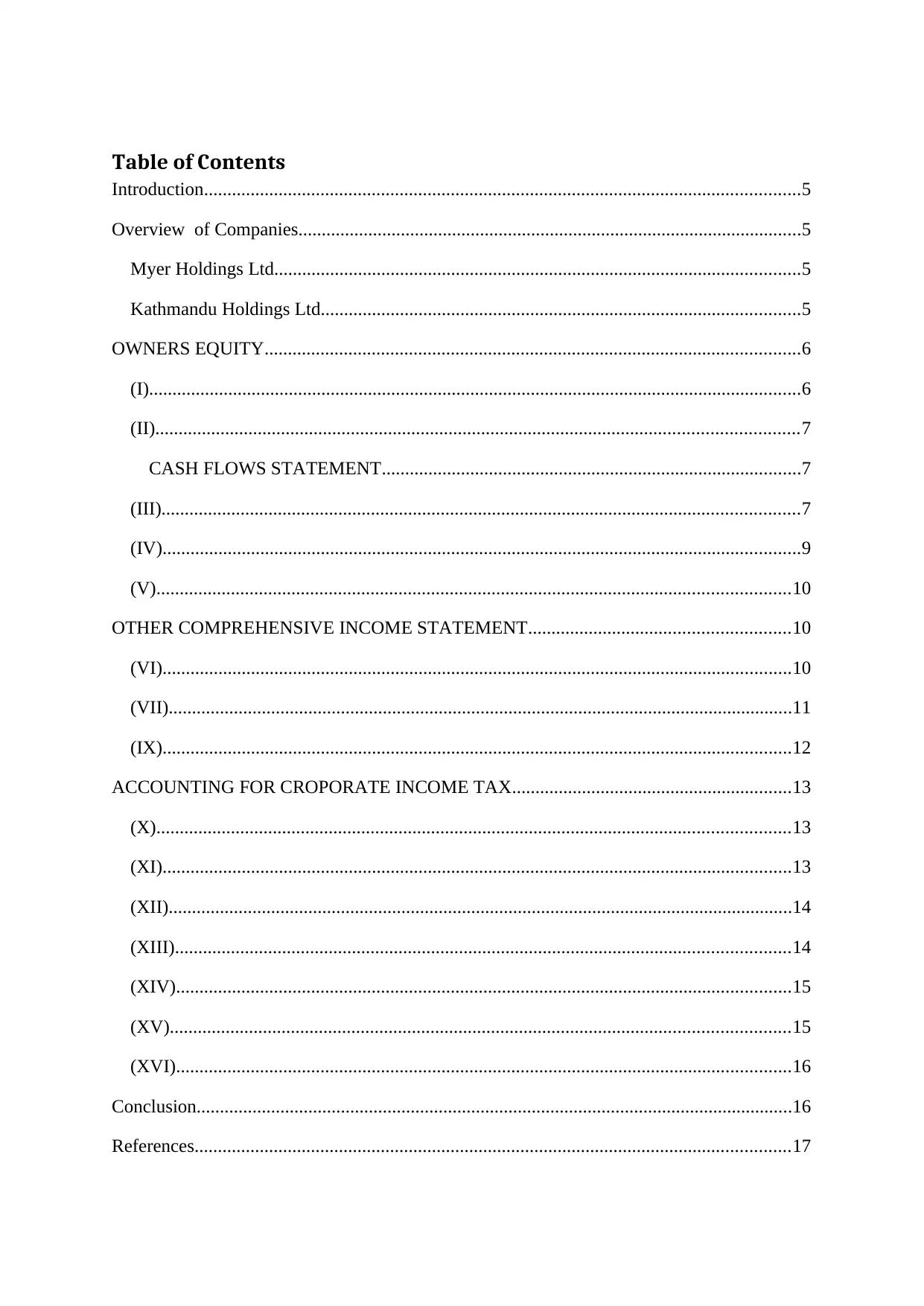
Table of Contents
Introduction................................................................................................................................5
Overview of Companies............................................................................................................5
Myer Holdings Ltd.................................................................................................................5
Kathmandu Holdings Ltd.......................................................................................................5
OWNERS EQUITY...................................................................................................................6
(I)............................................................................................................................................6
(II)..........................................................................................................................................7
CASH FLOWS STATEMENT..........................................................................................7
(III).........................................................................................................................................7
(IV).........................................................................................................................................9
(V)........................................................................................................................................10
OTHER COMPREHENSIVE INCOME STATEMENT........................................................10
(VI).......................................................................................................................................10
(VII)......................................................................................................................................11
(IX).......................................................................................................................................12
ACCOUNTING FOR CROPORATE INCOME TAX............................................................13
(X)........................................................................................................................................13
(XI).......................................................................................................................................13
(XII)......................................................................................................................................14
(XIII)....................................................................................................................................14
(XIV)....................................................................................................................................15
(XV).....................................................................................................................................15
(XVI)....................................................................................................................................16
Conclusion................................................................................................................................16
References................................................................................................................................17
Introduction................................................................................................................................5
Overview of Companies............................................................................................................5
Myer Holdings Ltd.................................................................................................................5
Kathmandu Holdings Ltd.......................................................................................................5
OWNERS EQUITY...................................................................................................................6
(I)............................................................................................................................................6
(II)..........................................................................................................................................7
CASH FLOWS STATEMENT..........................................................................................7
(III).........................................................................................................................................7
(IV).........................................................................................................................................9
(V)........................................................................................................................................10
OTHER COMPREHENSIVE INCOME STATEMENT........................................................10
(VI).......................................................................................................................................10
(VII)......................................................................................................................................11
(IX).......................................................................................................................................12
ACCOUNTING FOR CROPORATE INCOME TAX............................................................13
(X)........................................................................................................................................13
(XI).......................................................................................................................................13
(XII)......................................................................................................................................14
(XIII)....................................................................................................................................14
(XIV)....................................................................................................................................15
(XV).....................................................................................................................................15
(XVI)....................................................................................................................................16
Conclusion................................................................................................................................16
References................................................................................................................................17
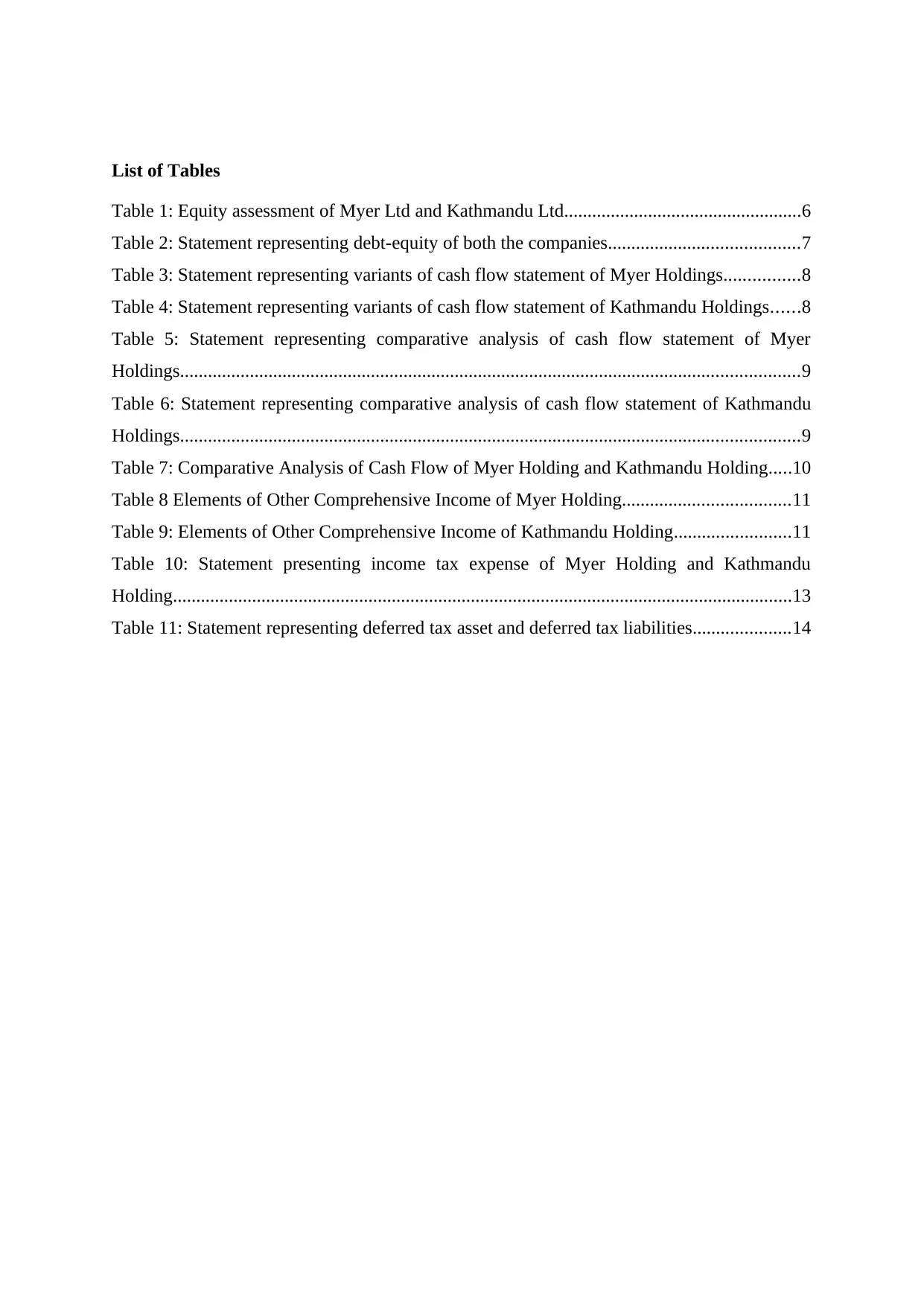
List of Tables
Table 1: Equity assessment of Myer Ltd and Kathmandu Ltd...................................................6
Table 2: Statement representing debt-equity of both the companies.........................................7
Table 3: Statement representing variants of cash flow statement of Myer Holdings................8
Table 4: Statement representing variants of cash flow statement of Kathmandu Holdings......8
Table 5: Statement representing comparative analysis of cash flow statement of Myer
Holdings.....................................................................................................................................9
Table 6: Statement representing comparative analysis of cash flow statement of Kathmandu
Holdings.....................................................................................................................................9
Table 7: Comparative Analysis of Cash Flow of Myer Holding and Kathmandu Holding.....10
Table 8 Elements of Other Comprehensive Income of Myer Holding....................................11
Table 9: Elements of Other Comprehensive Income of Kathmandu Holding.........................11
Table 10: Statement presenting income tax expense of Myer Holding and Kathmandu
Holding.....................................................................................................................................13
Table 11: Statement representing deferred tax asset and deferred tax liabilities.....................14
Table 1: Equity assessment of Myer Ltd and Kathmandu Ltd...................................................6
Table 2: Statement representing debt-equity of both the companies.........................................7
Table 3: Statement representing variants of cash flow statement of Myer Holdings................8
Table 4: Statement representing variants of cash flow statement of Kathmandu Holdings......8
Table 5: Statement representing comparative analysis of cash flow statement of Myer
Holdings.....................................................................................................................................9
Table 6: Statement representing comparative analysis of cash flow statement of Kathmandu
Holdings.....................................................................................................................................9
Table 7: Comparative Analysis of Cash Flow of Myer Holding and Kathmandu Holding.....10
Table 8 Elements of Other Comprehensive Income of Myer Holding....................................11
Table 9: Elements of Other Comprehensive Income of Kathmandu Holding.........................11
Table 10: Statement presenting income tax expense of Myer Holding and Kathmandu
Holding.....................................................................................................................................13
Table 11: Statement representing deferred tax asset and deferred tax liabilities.....................14
Secure Best Marks with AI Grader
Need help grading? Try our AI Grader for instant feedback on your assignments.
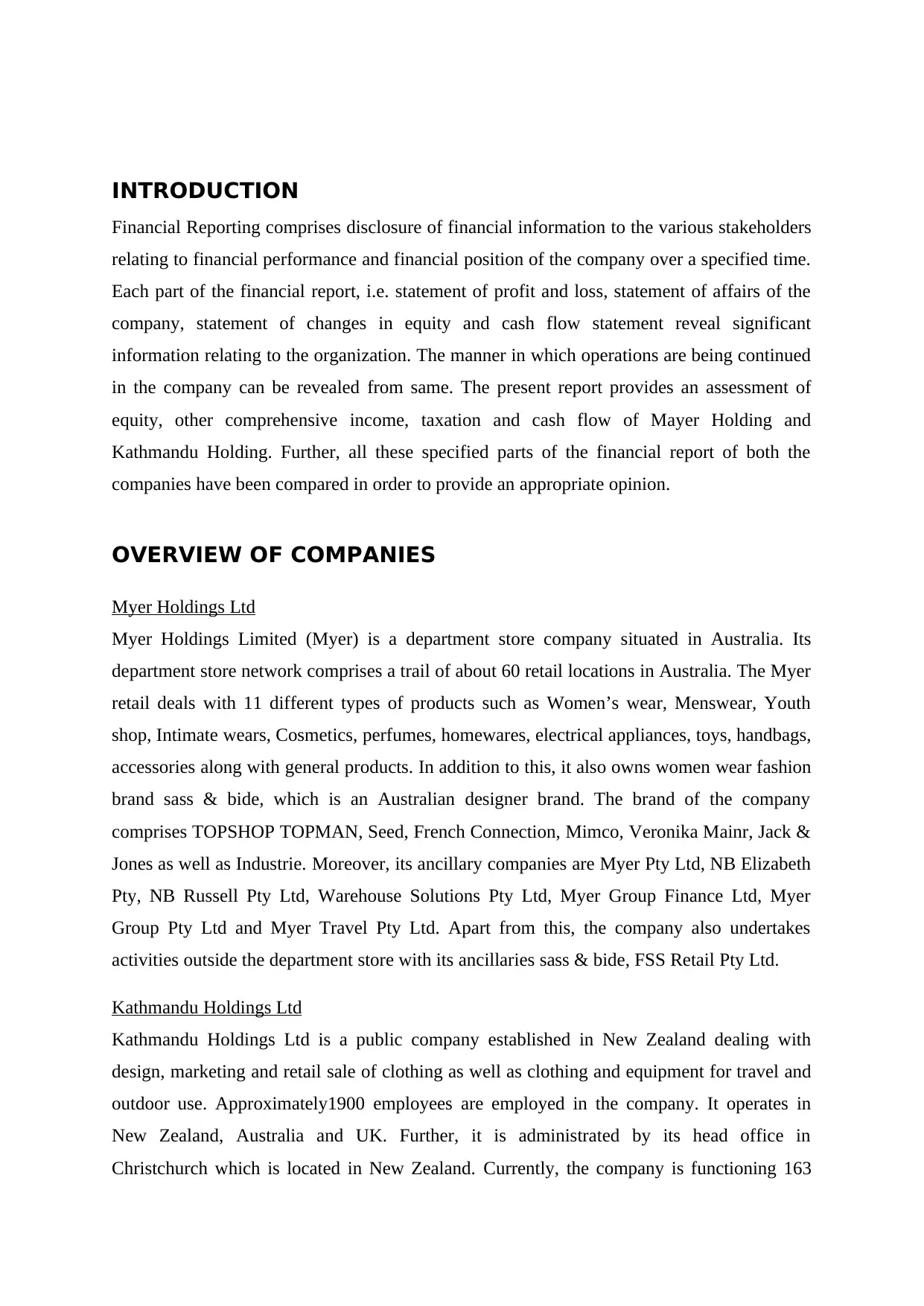
INTRODUCTION
Financial Reporting comprises disclosure of financial information to the various stakeholders
relating to financial performance and financial position of the company over a specified time.
Each part of the financial report, i.e. statement of profit and loss, statement of affairs of the
company, statement of changes in equity and cash flow statement reveal significant
information relating to the organization. The manner in which operations are being continued
in the company can be revealed from same. The present report provides an assessment of
equity, other comprehensive income, taxation and cash flow of Mayer Holding and
Kathmandu Holding. Further, all these specified parts of the financial report of both the
companies have been compared in order to provide an appropriate opinion.
OVERVIEW OF COMPANIES
Myer Holdings Ltd
Myer Holdings Limited (Myer) is a department store company situated in Australia. Its
department store network comprises a trail of about 60 retail locations in Australia. The Myer
retail deals with 11 different types of products such as Women’s wear, Menswear, Youth
shop, Intimate wears, Cosmetics, perfumes, homewares, electrical appliances, toys, handbags,
accessories along with general products. In addition to this, it also owns women wear fashion
brand sass & bide, which is an Australian designer brand. The brand of the company
comprises TOPSHOP TOPMAN, Seed, French Connection, Mimco, Veronika Mainr, Jack &
Jones as well as Industrie. Moreover, its ancillary companies are Myer Pty Ltd, NB Elizabeth
Pty, NB Russell Pty Ltd, Warehouse Solutions Pty Ltd, Myer Group Finance Ltd, Myer
Group Pty Ltd and Myer Travel Pty Ltd. Apart from this, the company also undertakes
activities outside the department store with its ancillaries sass & bide, FSS Retail Pty Ltd.
Kathmandu Holdings Ltd
Kathmandu Holdings Ltd is a public company established in New Zealand dealing with
design, marketing and retail sale of clothing as well as clothing and equipment for travel and
outdoor use. Approximately1900 employees are employed in the company. It operates in
New Zealand, Australia and UK. Further, it is administrated by its head office in
Christchurch which is located in New Zealand. Currently, the company is functioning 163
Financial Reporting comprises disclosure of financial information to the various stakeholders
relating to financial performance and financial position of the company over a specified time.
Each part of the financial report, i.e. statement of profit and loss, statement of affairs of the
company, statement of changes in equity and cash flow statement reveal significant
information relating to the organization. The manner in which operations are being continued
in the company can be revealed from same. The present report provides an assessment of
equity, other comprehensive income, taxation and cash flow of Mayer Holding and
Kathmandu Holding. Further, all these specified parts of the financial report of both the
companies have been compared in order to provide an appropriate opinion.
OVERVIEW OF COMPANIES
Myer Holdings Ltd
Myer Holdings Limited (Myer) is a department store company situated in Australia. Its
department store network comprises a trail of about 60 retail locations in Australia. The Myer
retail deals with 11 different types of products such as Women’s wear, Menswear, Youth
shop, Intimate wears, Cosmetics, perfumes, homewares, electrical appliances, toys, handbags,
accessories along with general products. In addition to this, it also owns women wear fashion
brand sass & bide, which is an Australian designer brand. The brand of the company
comprises TOPSHOP TOPMAN, Seed, French Connection, Mimco, Veronika Mainr, Jack &
Jones as well as Industrie. Moreover, its ancillary companies are Myer Pty Ltd, NB Elizabeth
Pty, NB Russell Pty Ltd, Warehouse Solutions Pty Ltd, Myer Group Finance Ltd, Myer
Group Pty Ltd and Myer Travel Pty Ltd. Apart from this, the company also undertakes
activities outside the department store with its ancillaries sass & bide, FSS Retail Pty Ltd.
Kathmandu Holdings Ltd
Kathmandu Holdings Ltd is a public company established in New Zealand dealing with
design, marketing and retail sale of clothing as well as clothing and equipment for travel and
outdoor use. Approximately1900 employees are employed in the company. It operates in
New Zealand, Australia and UK. Further, it is administrated by its head office in
Christchurch which is located in New Zealand. Currently, the company is functioning 163
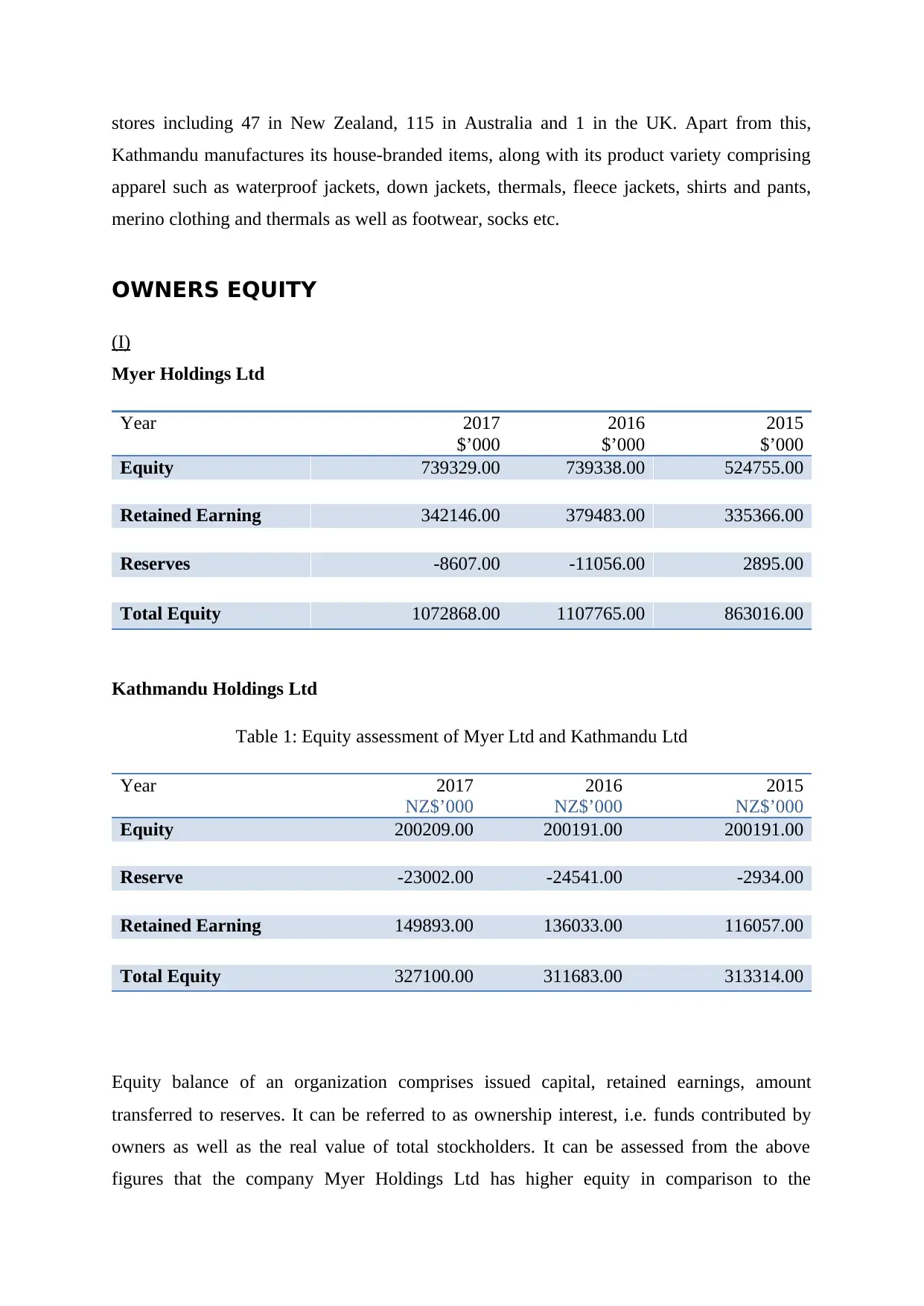
stores including 47 in New Zealand, 115 in Australia and 1 in the UK. Apart from this,
Kathmandu manufactures its house-branded items, along with its product variety comprising
apparel such as waterproof jackets, down jackets, thermals, fleece jackets, shirts and pants,
merino clothing and thermals as well as footwear, socks etc.
OWNERS EQUITY
(I)
Myer Holdings Ltd
Year 2017
$’000
2016
$’000
2015
$’000
Equity 739329.00 739338.00 524755.00
Retained Earning 342146.00 379483.00 335366.00
Reserves -8607.00 -11056.00 2895.00
Total Equity 1072868.00 1107765.00 863016.00
Kathmandu Holdings Ltd
Table 1: Equity assessment of Myer Ltd and Kathmandu Ltd
Year 2017
NZ$’000
2016
NZ$’000
2015
NZ$’000
Equity 200209.00 200191.00 200191.00
Reserve -23002.00 -24541.00 -2934.00
Retained Earning 149893.00 136033.00 116057.00
Total Equity 327100.00 311683.00 313314.00
Equity balance of an organization comprises issued capital, retained earnings, amount
transferred to reserves. It can be referred to as ownership interest, i.e. funds contributed by
owners as well as the real value of total stockholders. It can be assessed from the above
figures that the company Myer Holdings Ltd has higher equity in comparison to the
Kathmandu manufactures its house-branded items, along with its product variety comprising
apparel such as waterproof jackets, down jackets, thermals, fleece jackets, shirts and pants,
merino clothing and thermals as well as footwear, socks etc.
OWNERS EQUITY
(I)
Myer Holdings Ltd
Year 2017
$’000
2016
$’000
2015
$’000
Equity 739329.00 739338.00 524755.00
Retained Earning 342146.00 379483.00 335366.00
Reserves -8607.00 -11056.00 2895.00
Total Equity 1072868.00 1107765.00 863016.00
Kathmandu Holdings Ltd
Table 1: Equity assessment of Myer Ltd and Kathmandu Ltd
Year 2017
NZ$’000
2016
NZ$’000
2015
NZ$’000
Equity 200209.00 200191.00 200191.00
Reserve -23002.00 -24541.00 -2934.00
Retained Earning 149893.00 136033.00 116057.00
Total Equity 327100.00 311683.00 313314.00
Equity balance of an organization comprises issued capital, retained earnings, amount
transferred to reserves. It can be referred to as ownership interest, i.e. funds contributed by
owners as well as the real value of total stockholders. It can be assessed from the above
figures that the company Myer Holdings Ltd has higher equity in comparison to the
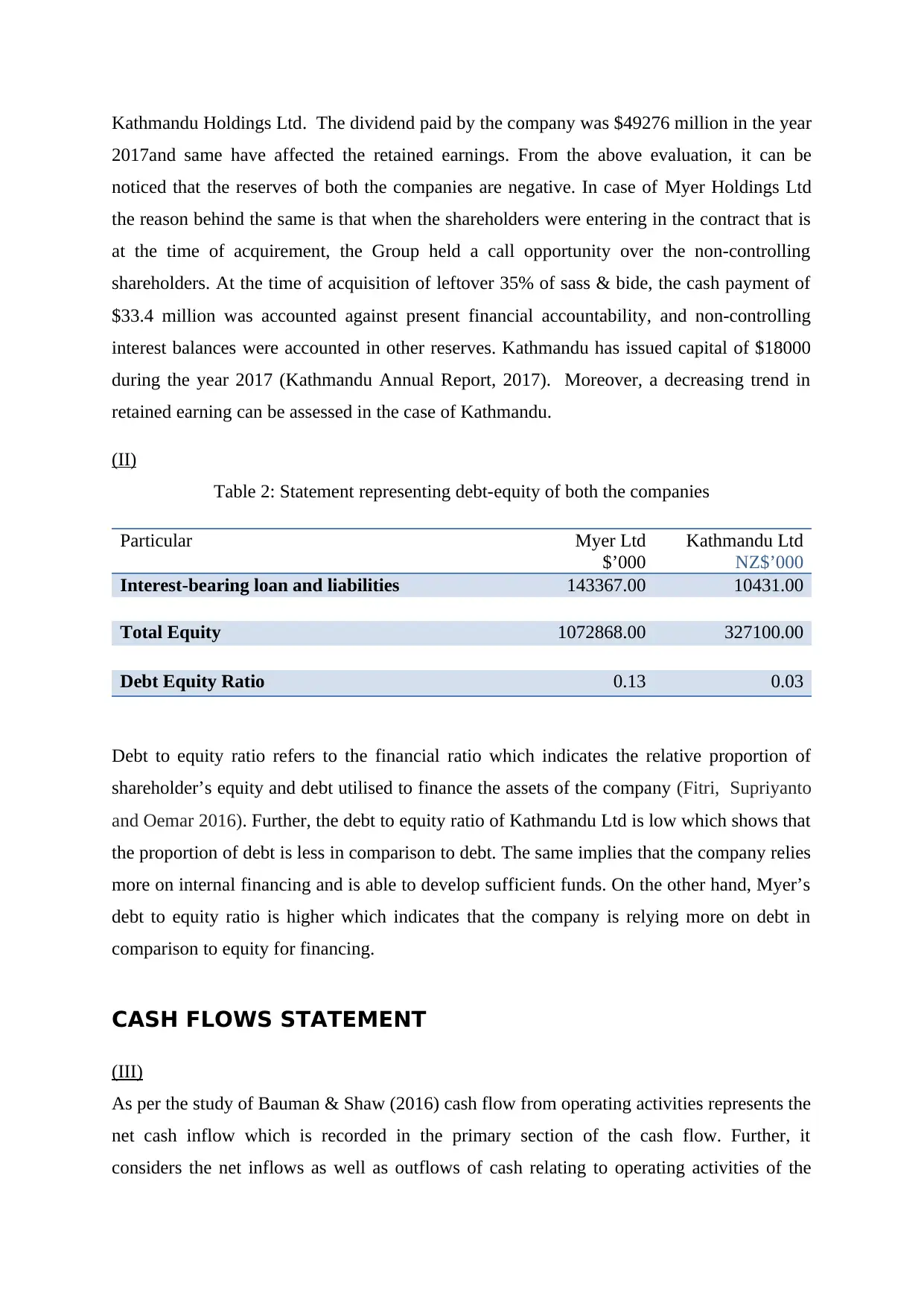
Kathmandu Holdings Ltd. The dividend paid by the company was $49276 million in the year
2017and same have affected the retained earnings. From the above evaluation, it can be
noticed that the reserves of both the companies are negative. In case of Myer Holdings Ltd
the reason behind the same is that when the shareholders were entering in the contract that is
at the time of acquirement, the Group held a call opportunity over the non-controlling
shareholders. At the time of acquisition of leftover 35% of sass & bide, the cash payment of
$33.4 million was accounted against present financial accountability, and non-controlling
interest balances were accounted in other reserves. Kathmandu has issued capital of $18000
during the year 2017 (Kathmandu Annual Report, 2017). Moreover, a decreasing trend in
retained earning can be assessed in the case of Kathmandu.
(II)
Table 2: Statement representing debt-equity of both the companies
Particular Myer Ltd
$’000
Kathmandu Ltd
NZ$’000
Interest-bearing loan and liabilities 143367.00 10431.00
Total Equity 1072868.00 327100.00
Debt Equity Ratio 0.13 0.03
Debt to equity ratio refers to the financial ratio which indicates the relative proportion of
shareholder’s equity and debt utilised to finance the assets of the company (Fitri, Supriyanto
and Oemar 2016). Further, the debt to equity ratio of Kathmandu Ltd is low which shows that
the proportion of debt is less in comparison to debt. The same implies that the company relies
more on internal financing and is able to develop sufficient funds. On the other hand, Myer’s
debt to equity ratio is higher which indicates that the company is relying more on debt in
comparison to equity for financing.
CASH FLOWS STATEMENT
(III)
As per the study of Bauman & Shaw (2016) cash flow from operating activities represents the
net cash inflow which is recorded in the primary section of the cash flow. Further, it
considers the net inflows as well as outflows of cash relating to operating activities of the
2017and same have affected the retained earnings. From the above evaluation, it can be
noticed that the reserves of both the companies are negative. In case of Myer Holdings Ltd
the reason behind the same is that when the shareholders were entering in the contract that is
at the time of acquirement, the Group held a call opportunity over the non-controlling
shareholders. At the time of acquisition of leftover 35% of sass & bide, the cash payment of
$33.4 million was accounted against present financial accountability, and non-controlling
interest balances were accounted in other reserves. Kathmandu has issued capital of $18000
during the year 2017 (Kathmandu Annual Report, 2017). Moreover, a decreasing trend in
retained earning can be assessed in the case of Kathmandu.
(II)
Table 2: Statement representing debt-equity of both the companies
Particular Myer Ltd
$’000
Kathmandu Ltd
NZ$’000
Interest-bearing loan and liabilities 143367.00 10431.00
Total Equity 1072868.00 327100.00
Debt Equity Ratio 0.13 0.03
Debt to equity ratio refers to the financial ratio which indicates the relative proportion of
shareholder’s equity and debt utilised to finance the assets of the company (Fitri, Supriyanto
and Oemar 2016). Further, the debt to equity ratio of Kathmandu Ltd is low which shows that
the proportion of debt is less in comparison to debt. The same implies that the company relies
more on internal financing and is able to develop sufficient funds. On the other hand, Myer’s
debt to equity ratio is higher which indicates that the company is relying more on debt in
comparison to equity for financing.
CASH FLOWS STATEMENT
(III)
As per the study of Bauman & Shaw (2016) cash flow from operating activities represents the
net cash inflow which is recorded in the primary section of the cash flow. Further, it
considers the net inflows as well as outflows of cash relating to operating activities of the
Paraphrase This Document
Need a fresh take? Get an instant paraphrase of this document with our AI Paraphraser
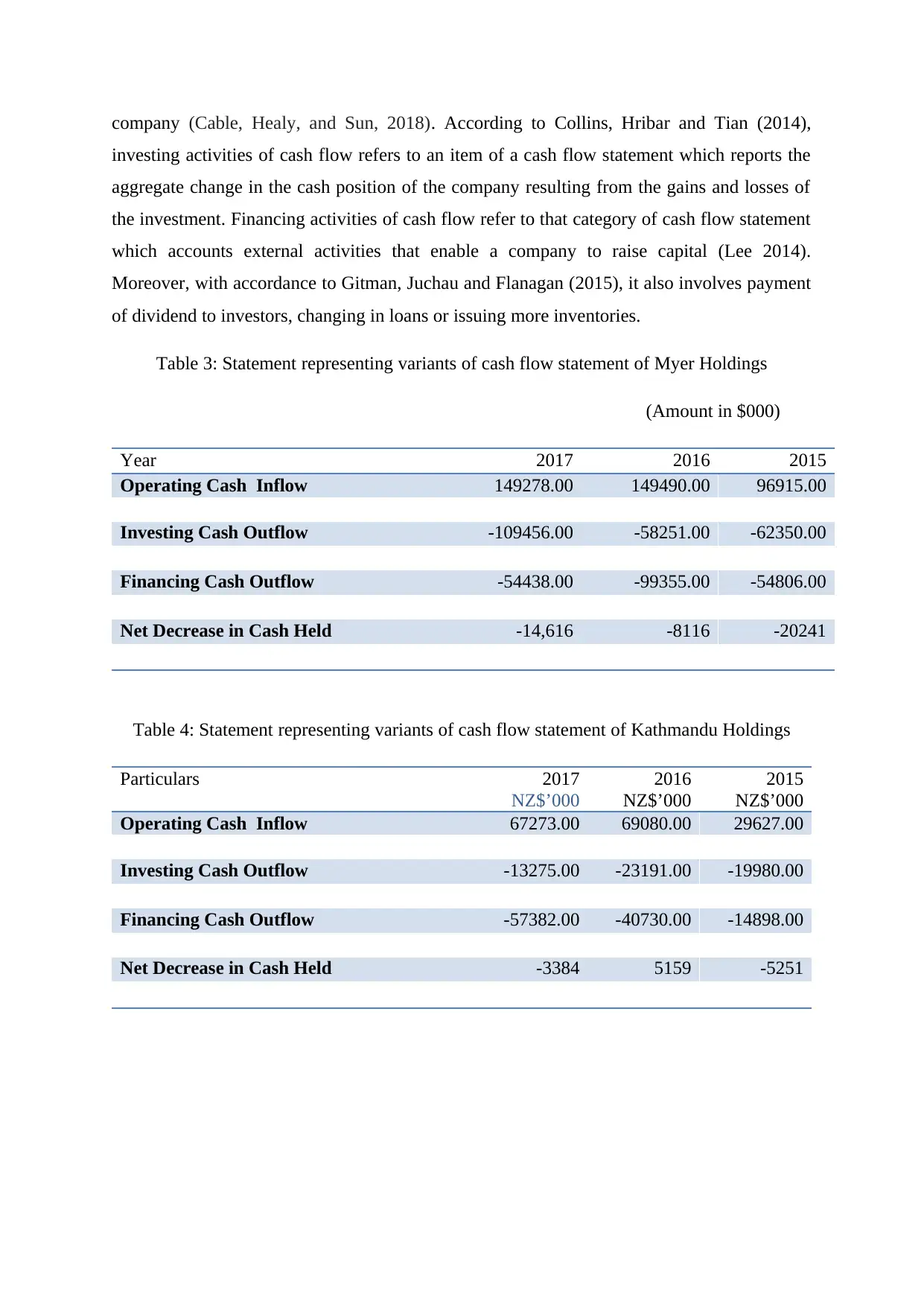
company (Cable, Healy, and Sun, 2018). According to Collins, Hribar and Tian (2014),
investing activities of cash flow refers to an item of a cash flow statement which reports the
aggregate change in the cash position of the company resulting from the gains and losses of
the investment. Financing activities of cash flow refer to that category of cash flow statement
which accounts external activities that enable a company to raise capital (Lee 2014).
Moreover, with accordance to Gitman, Juchau and Flanagan (2015), it also involves payment
of dividend to investors, changing in loans or issuing more inventories.
Table 3: Statement representing variants of cash flow statement of Myer Holdings
(Amount in $000)
Year 2017 2016 2015
Operating Cash Inflow 149278.00 149490.00 96915.00
Investing Cash Outflow -109456.00 -58251.00 -62350.00
Financing Cash Outflow -54438.00 -99355.00 -54806.00
Net Decrease in Cash Held -14,616 -8116 -20241
Table 4: Statement representing variants of cash flow statement of Kathmandu Holdings
Particulars 2017
NZ$’000
2016
NZ$’000
2015
NZ$’000
Operating Cash Inflow 67273.00 69080.00 29627.00
Investing Cash Outflow -13275.00 -23191.00 -19980.00
Financing Cash Outflow -57382.00 -40730.00 -14898.00
Net Decrease in Cash Held -3384 5159 -5251
investing activities of cash flow refers to an item of a cash flow statement which reports the
aggregate change in the cash position of the company resulting from the gains and losses of
the investment. Financing activities of cash flow refer to that category of cash flow statement
which accounts external activities that enable a company to raise capital (Lee 2014).
Moreover, with accordance to Gitman, Juchau and Flanagan (2015), it also involves payment
of dividend to investors, changing in loans or issuing more inventories.
Table 3: Statement representing variants of cash flow statement of Myer Holdings
(Amount in $000)
Year 2017 2016 2015
Operating Cash Inflow 149278.00 149490.00 96915.00
Investing Cash Outflow -109456.00 -58251.00 -62350.00
Financing Cash Outflow -54438.00 -99355.00 -54806.00
Net Decrease in Cash Held -14,616 -8116 -20241
Table 4: Statement representing variants of cash flow statement of Kathmandu Holdings
Particulars 2017
NZ$’000
2016
NZ$’000
2015
NZ$’000
Operating Cash Inflow 67273.00 69080.00 29627.00
Investing Cash Outflow -13275.00 -23191.00 -19980.00
Financing Cash Outflow -57382.00 -40730.00 -14898.00
Net Decrease in Cash Held -3384 5159 -5251
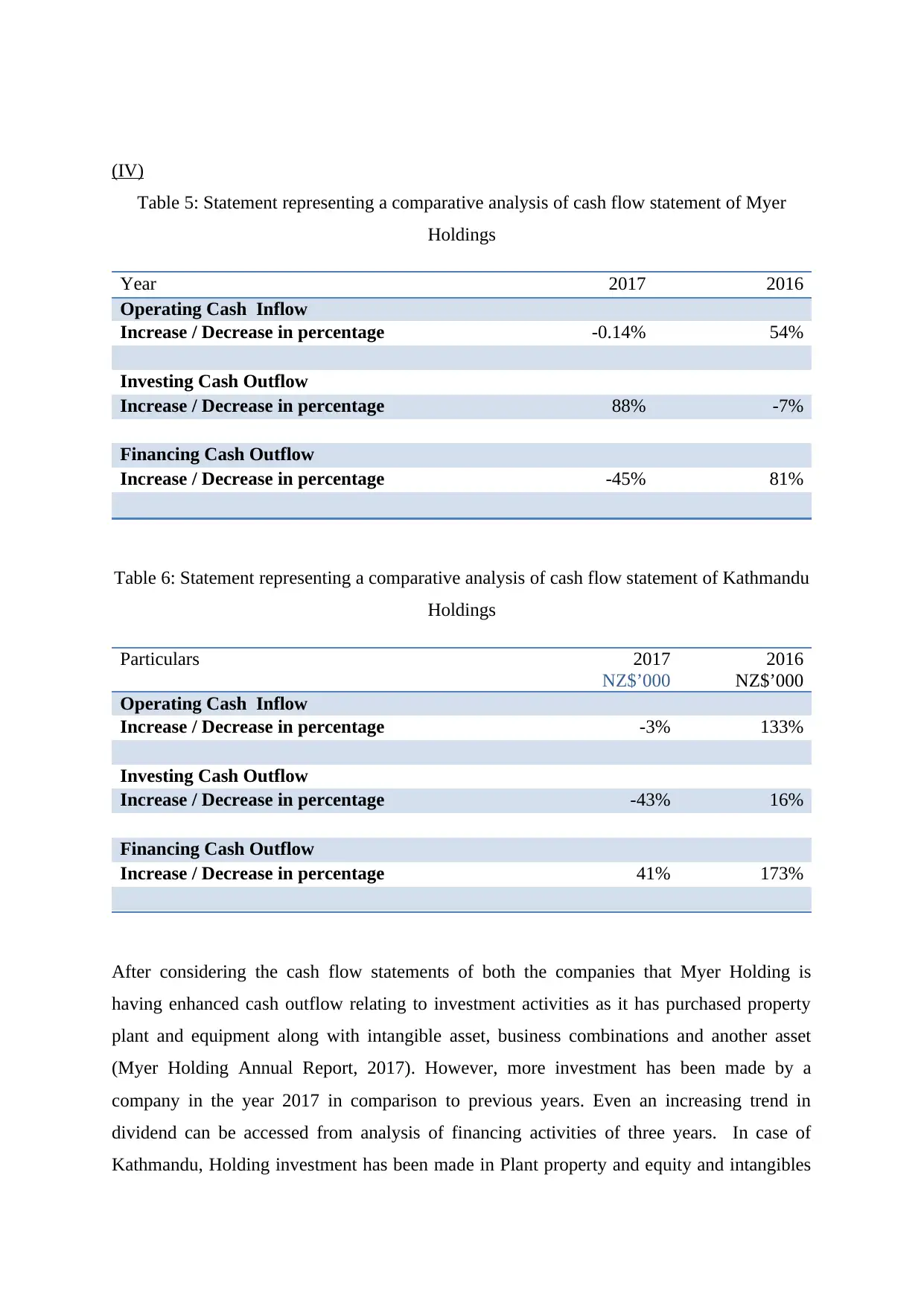
(IV)
Table 5: Statement representing a comparative analysis of cash flow statement of Myer
Holdings
Year 2017 2016
Operating Cash Inflow
Increase / Decrease in percentage -0.14% 54%
Investing Cash Outflow
Increase / Decrease in percentage 88% -7%
Financing Cash Outflow
Increase / Decrease in percentage -45% 81%
Table 6: Statement representing a comparative analysis of cash flow statement of Kathmandu
Holdings
Particulars 2017
NZ$’000
2016
NZ$’000
Operating Cash Inflow
Increase / Decrease in percentage -3% 133%
Investing Cash Outflow
Increase / Decrease in percentage -43% 16%
Financing Cash Outflow
Increase / Decrease in percentage 41% 173%
After considering the cash flow statements of both the companies that Myer Holding is
having enhanced cash outflow relating to investment activities as it has purchased property
plant and equipment along with intangible asset, business combinations and another asset
(Myer Holding Annual Report, 2017). However, more investment has been made by a
company in the year 2017 in comparison to previous years. Even an increasing trend in
dividend can be accessed from analysis of financing activities of three years. In case of
Kathmandu, Holding investment has been made in Plant property and equity and intangibles
Table 5: Statement representing a comparative analysis of cash flow statement of Myer
Holdings
Year 2017 2016
Operating Cash Inflow
Increase / Decrease in percentage -0.14% 54%
Investing Cash Outflow
Increase / Decrease in percentage 88% -7%
Financing Cash Outflow
Increase / Decrease in percentage -45% 81%
Table 6: Statement representing a comparative analysis of cash flow statement of Kathmandu
Holdings
Particulars 2017
NZ$’000
2016
NZ$’000
Operating Cash Inflow
Increase / Decrease in percentage -3% 133%
Investing Cash Outflow
Increase / Decrease in percentage -43% 16%
Financing Cash Outflow
Increase / Decrease in percentage 41% 173%
After considering the cash flow statements of both the companies that Myer Holding is
having enhanced cash outflow relating to investment activities as it has purchased property
plant and equipment along with intangible asset, business combinations and another asset
(Myer Holding Annual Report, 2017). However, more investment has been made by a
company in the year 2017 in comparison to previous years. Even an increasing trend in
dividend can be accessed from analysis of financing activities of three years. In case of
Kathmandu, Holding investment has been made in Plant property and equity and intangibles
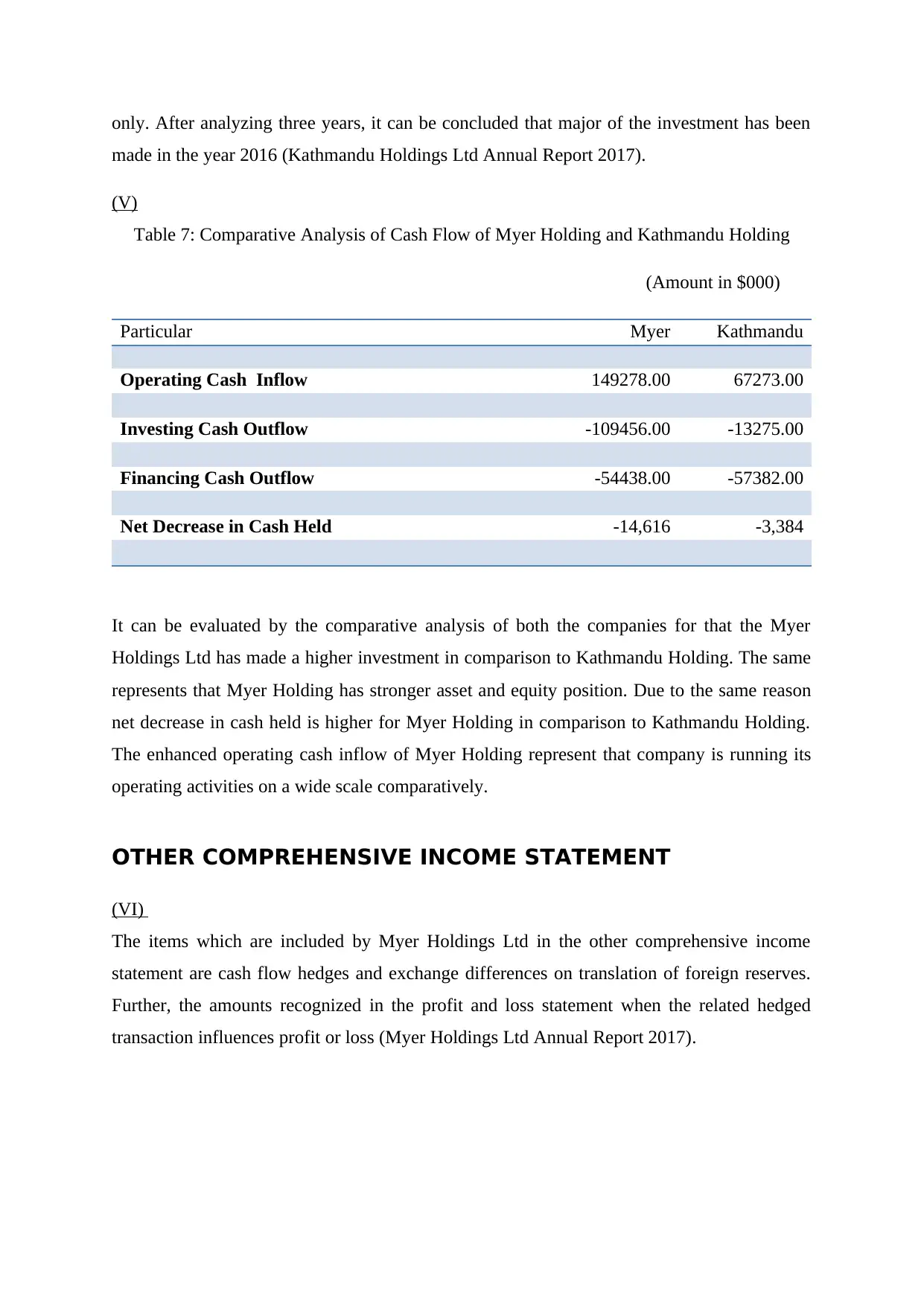
only. After analyzing three years, it can be concluded that major of the investment has been
made in the year 2016 (Kathmandu Holdings Ltd Annual Report 2017).
(V)
Table 7: Comparative Analysis of Cash Flow of Myer Holding and Kathmandu Holding
(Amount in $000)
Particular Myer Kathmandu
Operating Cash Inflow 149278.00 67273.00
Investing Cash Outflow -109456.00 -13275.00
Financing Cash Outflow -54438.00 -57382.00
Net Decrease in Cash Held -14,616 -3,384
It can be evaluated by the comparative analysis of both the companies for that the Myer
Holdings Ltd has made a higher investment in comparison to Kathmandu Holding. The same
represents that Myer Holding has stronger asset and equity position. Due to the same reason
net decrease in cash held is higher for Myer Holding in comparison to Kathmandu Holding.
The enhanced operating cash inflow of Myer Holding represent that company is running its
operating activities on a wide scale comparatively.
OTHER COMPREHENSIVE INCOME STATEMENT
(VI)
The items which are included by Myer Holdings Ltd in the other comprehensive income
statement are cash flow hedges and exchange differences on translation of foreign reserves.
Further, the amounts recognized in the profit and loss statement when the related hedged
transaction influences profit or loss (Myer Holdings Ltd Annual Report 2017).
made in the year 2016 (Kathmandu Holdings Ltd Annual Report 2017).
(V)
Table 7: Comparative Analysis of Cash Flow of Myer Holding and Kathmandu Holding
(Amount in $000)
Particular Myer Kathmandu
Operating Cash Inflow 149278.00 67273.00
Investing Cash Outflow -109456.00 -13275.00
Financing Cash Outflow -54438.00 -57382.00
Net Decrease in Cash Held -14,616 -3,384
It can be evaluated by the comparative analysis of both the companies for that the Myer
Holdings Ltd has made a higher investment in comparison to Kathmandu Holding. The same
represents that Myer Holding has stronger asset and equity position. Due to the same reason
net decrease in cash held is higher for Myer Holding in comparison to Kathmandu Holding.
The enhanced operating cash inflow of Myer Holding represent that company is running its
operating activities on a wide scale comparatively.
OTHER COMPREHENSIVE INCOME STATEMENT
(VI)
The items which are included by Myer Holdings Ltd in the other comprehensive income
statement are cash flow hedges and exchange differences on translation of foreign reserves.
Further, the amounts recognized in the profit and loss statement when the related hedged
transaction influences profit or loss (Myer Holdings Ltd Annual Report 2017).
Secure Best Marks with AI Grader
Need help grading? Try our AI Grader for instant feedback on your assignments.
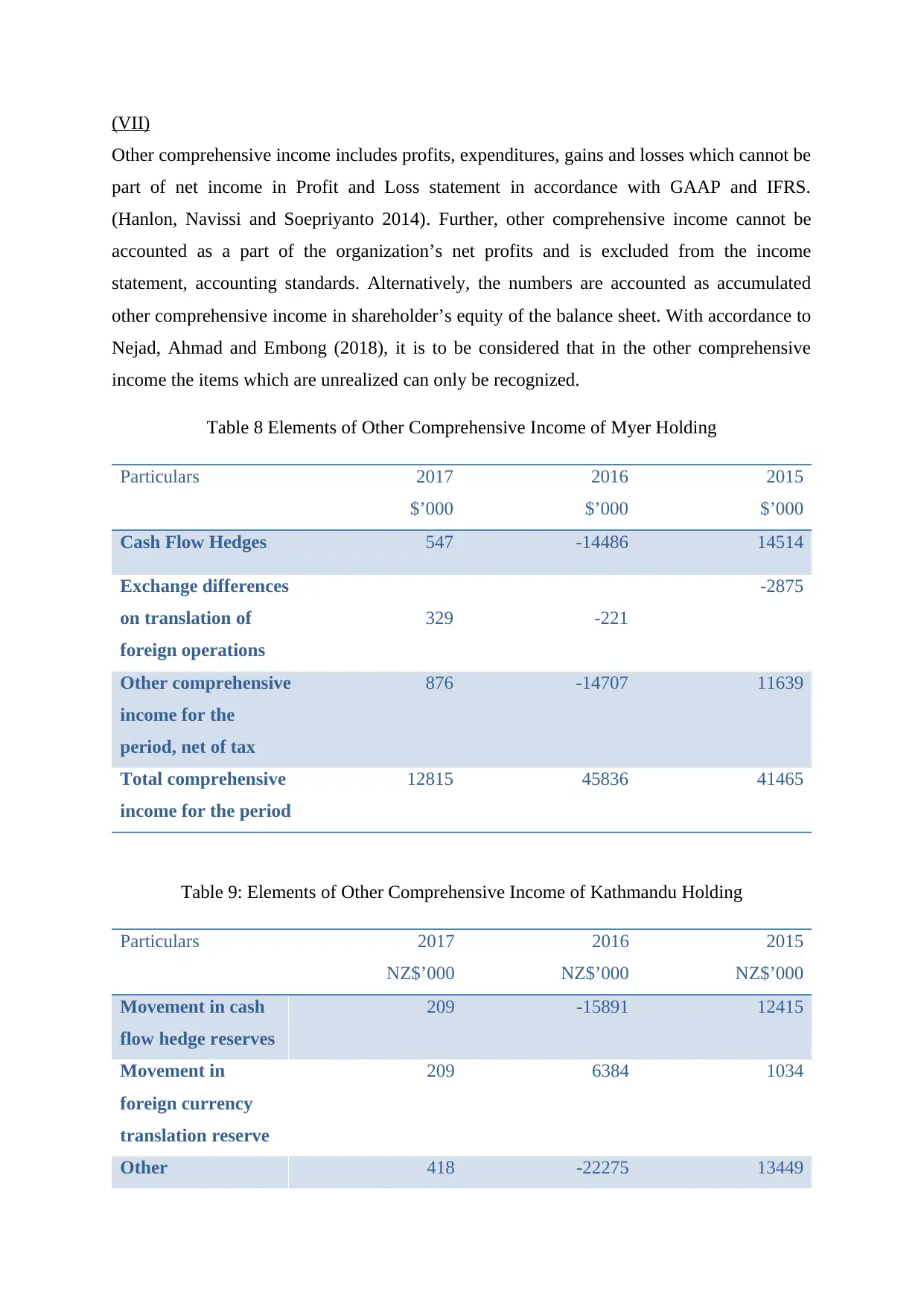
(VII)
Other comprehensive income includes profits, expenditures, gains and losses which cannot be
part of net income in Profit and Loss statement in accordance with GAAP and IFRS.
(Hanlon, Navissi and Soepriyanto 2014). Further, other comprehensive income cannot be
accounted as a part of the organization’s net profits and is excluded from the income
statement, accounting standards. Alternatively, the numbers are accounted as accumulated
other comprehensive income in shareholder’s equity of the balance sheet. With accordance to
Nejad, Ahmad and Embong (2018), it is to be considered that in the other comprehensive
income the items which are unrealized can only be recognized.
Table 8 Elements of Other Comprehensive Income of Myer Holding
Particulars 2017
$’000
2016
$’000
2015
$’000
Cash Flow Hedges 547 -14486 14514
Exchange differences
on translation of
foreign operations
329 -221
-2875
Other comprehensive
income for the
period, net of tax
876 -14707 11639
Total comprehensive
income for the period
12815 45836 41465
Table 9: Elements of Other Comprehensive Income of Kathmandu Holding
Particulars 2017
NZ$’000
2016
NZ$’000
2015
NZ$’000
Movement in cash
flow hedge reserves
209 -15891 12415
Movement in
foreign currency
translation reserve
209 6384 1034
Other 418 -22275 13449
Other comprehensive income includes profits, expenditures, gains and losses which cannot be
part of net income in Profit and Loss statement in accordance with GAAP and IFRS.
(Hanlon, Navissi and Soepriyanto 2014). Further, other comprehensive income cannot be
accounted as a part of the organization’s net profits and is excluded from the income
statement, accounting standards. Alternatively, the numbers are accounted as accumulated
other comprehensive income in shareholder’s equity of the balance sheet. With accordance to
Nejad, Ahmad and Embong (2018), it is to be considered that in the other comprehensive
income the items which are unrealized can only be recognized.
Table 8 Elements of Other Comprehensive Income of Myer Holding
Particulars 2017
$’000
2016
$’000
2015
$’000
Cash Flow Hedges 547 -14486 14514
Exchange differences
on translation of
foreign operations
329 -221
-2875
Other comprehensive
income for the
period, net of tax
876 -14707 11639
Total comprehensive
income for the period
12815 45836 41465
Table 9: Elements of Other Comprehensive Income of Kathmandu Holding
Particulars 2017
NZ$’000
2016
NZ$’000
2015
NZ$’000
Movement in cash
flow hedge reserves
209 -15891 12415
Movement in
foreign currency
translation reserve
209 6384 1034
Other 418 -22275 13449
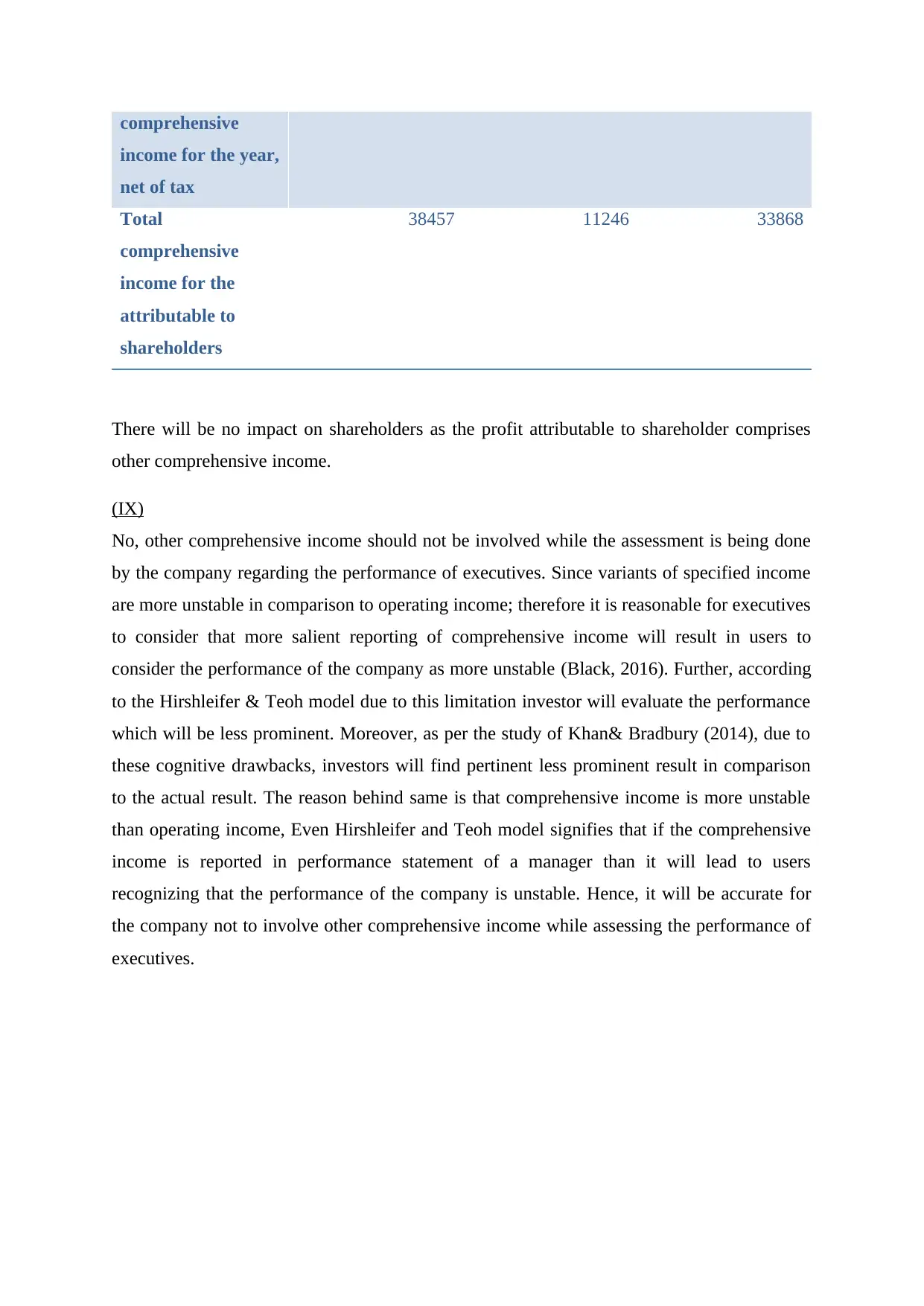
comprehensive
income for the year,
net of tax
Total
comprehensive
income for the
attributable to
shareholders
38457 11246 33868
There will be no impact on shareholders as the profit attributable to shareholder comprises
other comprehensive income.
(IX)
No, other comprehensive income should not be involved while the assessment is being done
by the company regarding the performance of executives. Since variants of specified income
are more unstable in comparison to operating income; therefore it is reasonable for executives
to consider that more salient reporting of comprehensive income will result in users to
consider the performance of the company as more unstable (Black, 2016). Further, according
to the Hirshleifer & Teoh model due to this limitation investor will evaluate the performance
which will be less prominent. Moreover, as per the study of Khan& Bradbury (2014), due to
these cognitive drawbacks, investors will find pertinent less prominent result in comparison
to the actual result. The reason behind same is that comprehensive income is more unstable
than operating income, Even Hirshleifer and Teoh model signifies that if the comprehensive
income is reported in performance statement of a manager than it will lead to users
recognizing that the performance of the company is unstable. Hence, it will be accurate for
the company not to involve other comprehensive income while assessing the performance of
executives.
income for the year,
net of tax
Total
comprehensive
income for the
attributable to
shareholders
38457 11246 33868
There will be no impact on shareholders as the profit attributable to shareholder comprises
other comprehensive income.
(IX)
No, other comprehensive income should not be involved while the assessment is being done
by the company regarding the performance of executives. Since variants of specified income
are more unstable in comparison to operating income; therefore it is reasonable for executives
to consider that more salient reporting of comprehensive income will result in users to
consider the performance of the company as more unstable (Black, 2016). Further, according
to the Hirshleifer & Teoh model due to this limitation investor will evaluate the performance
which will be less prominent. Moreover, as per the study of Khan& Bradbury (2014), due to
these cognitive drawbacks, investors will find pertinent less prominent result in comparison
to the actual result. The reason behind same is that comprehensive income is more unstable
than operating income, Even Hirshleifer and Teoh model signifies that if the comprehensive
income is reported in performance statement of a manager than it will lead to users
recognizing that the performance of the company is unstable. Hence, it will be accurate for
the company not to involve other comprehensive income while assessing the performance of
executives.
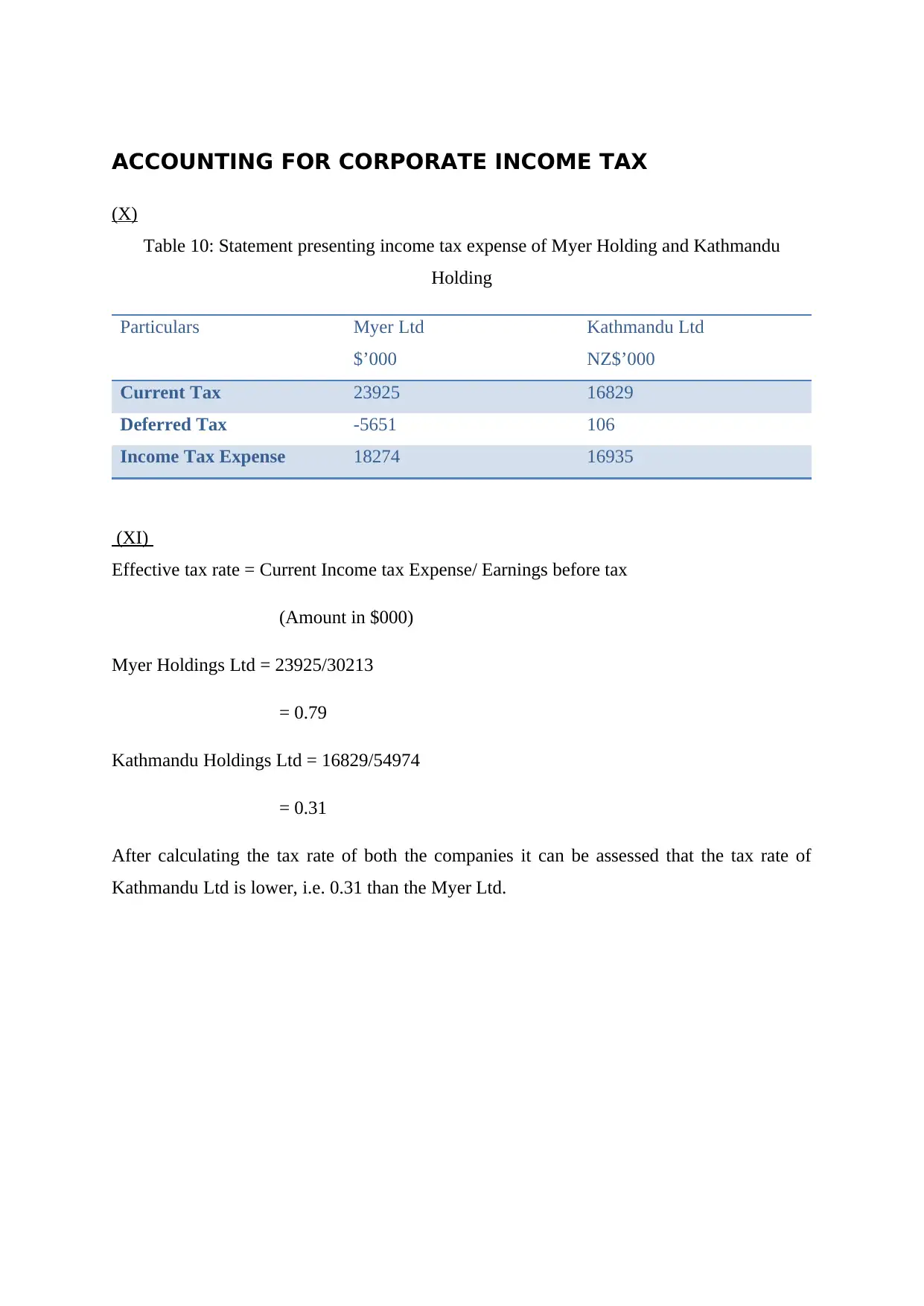
ACCOUNTING FOR CORPORATE INCOME TAX
(X)
Table 10: Statement presenting income tax expense of Myer Holding and Kathmandu
Holding
Particulars Myer Ltd
$’000
Kathmandu Ltd
NZ$’000
Current Tax 23925 16829
Deferred Tax -5651 106
Income Tax Expense 18274 16935
(XI)
Effective tax rate = Current Income tax Expense/ Earnings before tax
(Amount in $000)
Myer Holdings Ltd = 23925/30213
= 0.79
Kathmandu Holdings Ltd = 16829/54974
= 0.31
After calculating the tax rate of both the companies it can be assessed that the tax rate of
Kathmandu Ltd is lower, i.e. 0.31 than the Myer Ltd.
(X)
Table 10: Statement presenting income tax expense of Myer Holding and Kathmandu
Holding
Particulars Myer Ltd
$’000
Kathmandu Ltd
NZ$’000
Current Tax 23925 16829
Deferred Tax -5651 106
Income Tax Expense 18274 16935
(XI)
Effective tax rate = Current Income tax Expense/ Earnings before tax
(Amount in $000)
Myer Holdings Ltd = 23925/30213
= 0.79
Kathmandu Holdings Ltd = 16829/54974
= 0.31
After calculating the tax rate of both the companies it can be assessed that the tax rate of
Kathmandu Ltd is lower, i.e. 0.31 than the Myer Ltd.
Paraphrase This Document
Need a fresh take? Get an instant paraphrase of this document with our AI Paraphraser
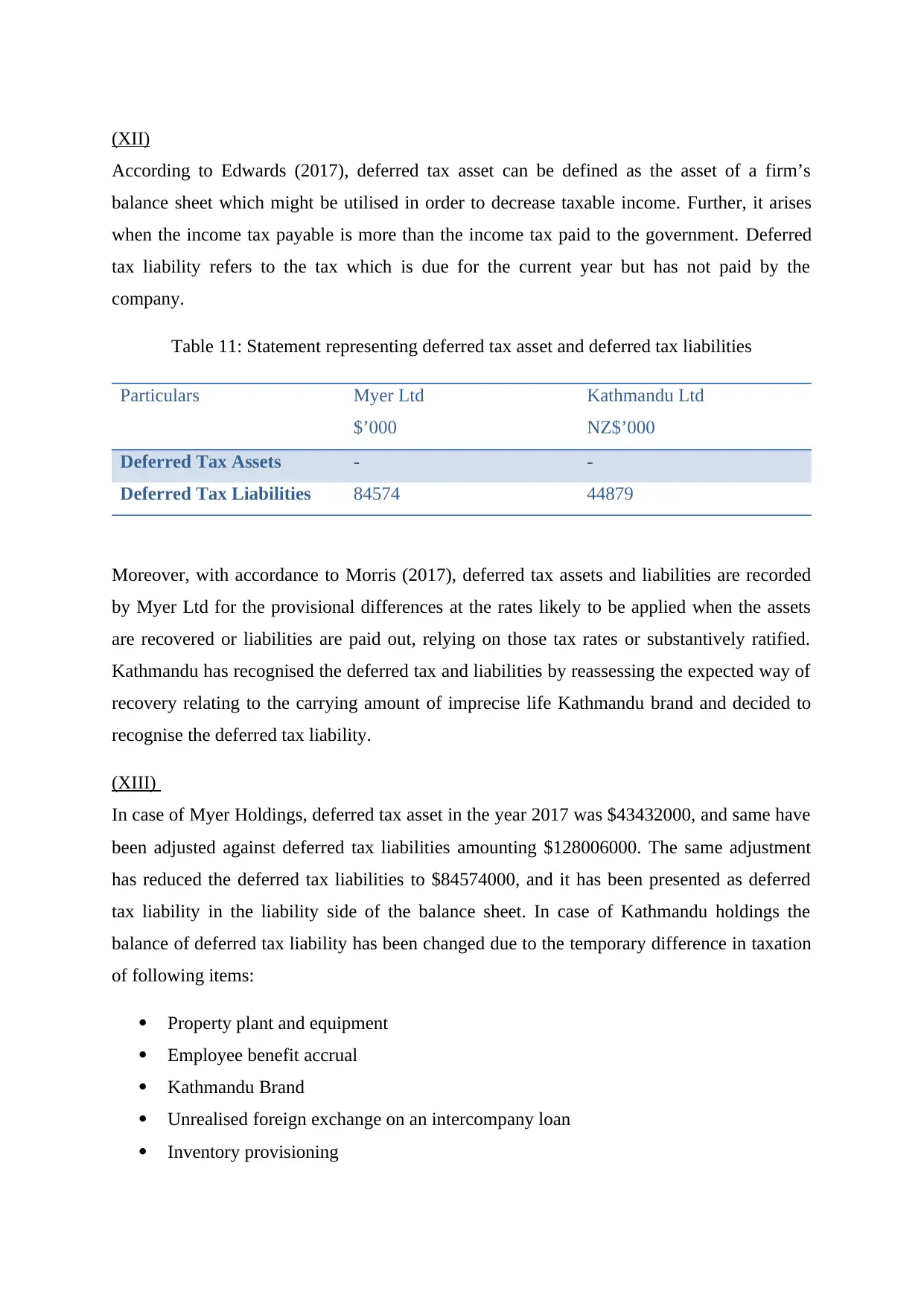
(XII)
According to Edwards (2017), deferred tax asset can be defined as the asset of a firm’s
balance sheet which might be utilised in order to decrease taxable income. Further, it arises
when the income tax payable is more than the income tax paid to the government. Deferred
tax liability refers to the tax which is due for the current year but has not paid by the
company.
Table 11: Statement representing deferred tax asset and deferred tax liabilities
Particulars Myer Ltd
$’000
Kathmandu Ltd
NZ$’000
Deferred Tax Assets - -
Deferred Tax Liabilities 84574 44879
Moreover, with accordance to Morris (2017), deferred tax assets and liabilities are recorded
by Myer Ltd for the provisional differences at the rates likely to be applied when the assets
are recovered or liabilities are paid out, relying on those tax rates or substantively ratified.
Kathmandu has recognised the deferred tax and liabilities by reassessing the expected way of
recovery relating to the carrying amount of imprecise life Kathmandu brand and decided to
recognise the deferred tax liability.
(XIII)
In case of Myer Holdings, deferred tax asset in the year 2017 was $43432000, and same have
been adjusted against deferred tax liabilities amounting $128006000. The same adjustment
has reduced the deferred tax liabilities to $84574000, and it has been presented as deferred
tax liability in the liability side of the balance sheet. In case of Kathmandu holdings the
balance of deferred tax liability has been changed due to the temporary difference in taxation
of following items:
Property plant and equipment
Employee benefit accrual
Kathmandu Brand
Unrealised foreign exchange on an intercompany loan
Inventory provisioning
According to Edwards (2017), deferred tax asset can be defined as the asset of a firm’s
balance sheet which might be utilised in order to decrease taxable income. Further, it arises
when the income tax payable is more than the income tax paid to the government. Deferred
tax liability refers to the tax which is due for the current year but has not paid by the
company.
Table 11: Statement representing deferred tax asset and deferred tax liabilities
Particulars Myer Ltd
$’000
Kathmandu Ltd
NZ$’000
Deferred Tax Assets - -
Deferred Tax Liabilities 84574 44879
Moreover, with accordance to Morris (2017), deferred tax assets and liabilities are recorded
by Myer Ltd for the provisional differences at the rates likely to be applied when the assets
are recovered or liabilities are paid out, relying on those tax rates or substantively ratified.
Kathmandu has recognised the deferred tax and liabilities by reassessing the expected way of
recovery relating to the carrying amount of imprecise life Kathmandu brand and decided to
recognise the deferred tax liability.
(XIII)
In case of Myer Holdings, deferred tax asset in the year 2017 was $43432000, and same have
been adjusted against deferred tax liabilities amounting $128006000. The same adjustment
has reduced the deferred tax liabilities to $84574000, and it has been presented as deferred
tax liability in the liability side of the balance sheet. In case of Kathmandu holdings the
balance of deferred tax liability has been changed due to the temporary difference in taxation
of following items:
Property plant and equipment
Employee benefit accrual
Kathmandu Brand
Unrealised foreign exchange on an intercompany loan
Inventory provisioning
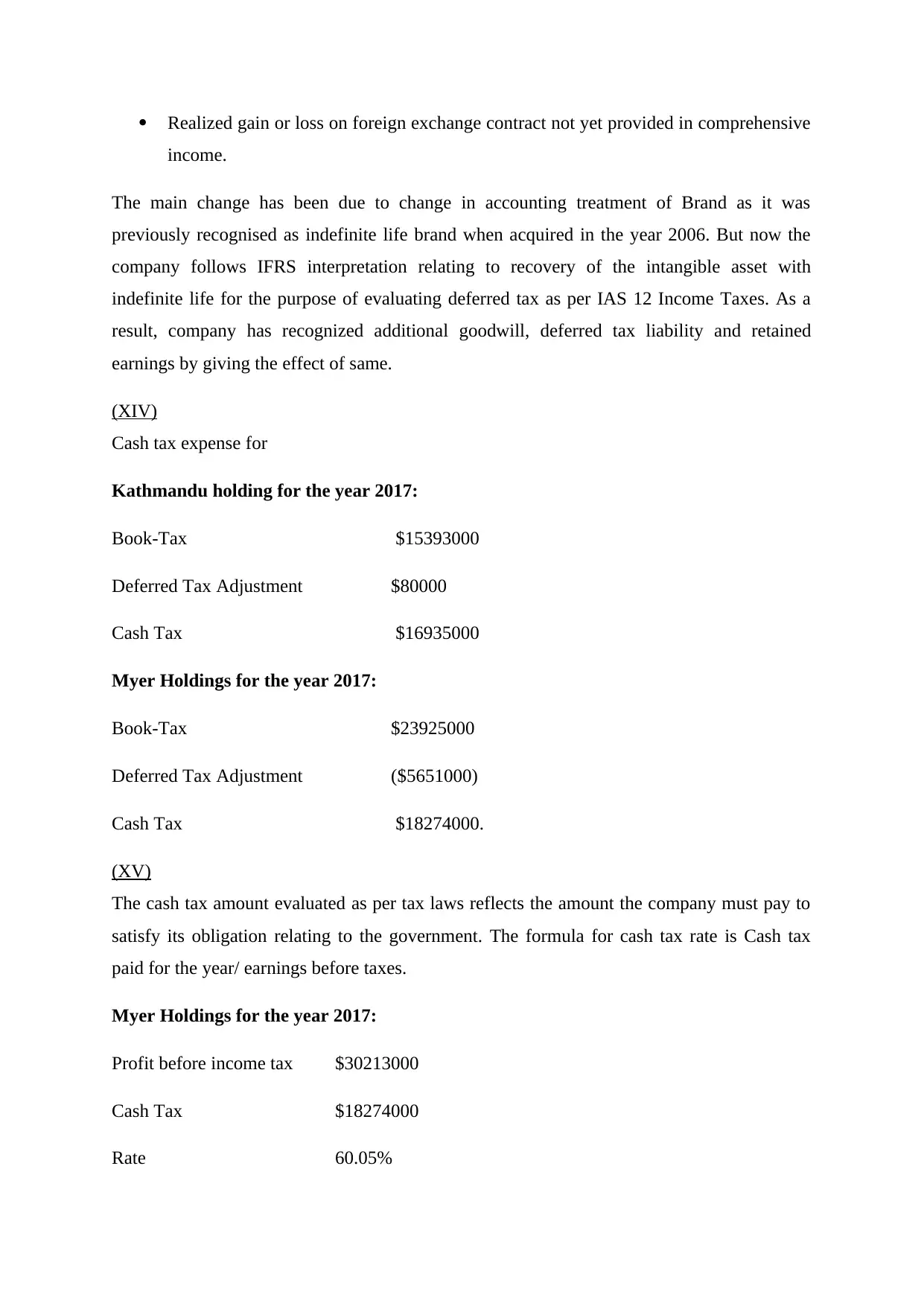
Realized gain or loss on foreign exchange contract not yet provided in comprehensive
income.
The main change has been due to change in accounting treatment of Brand as it was
previously recognised as indefinite life brand when acquired in the year 2006. But now the
company follows IFRS interpretation relating to recovery of the intangible asset with
indefinite life for the purpose of evaluating deferred tax as per IAS 12 Income Taxes. As a
result, company has recognized additional goodwill, deferred tax liability and retained
earnings by giving the effect of same.
(XIV)
Cash tax expense for
Kathmandu holding for the year 2017:
Book-Tax $15393000
Deferred Tax Adjustment $80000
Cash Tax $16935000
Myer Holdings for the year 2017:
Book-Tax $23925000
Deferred Tax Adjustment ($5651000)
Cash Tax $18274000.
(XV)
The cash tax amount evaluated as per tax laws reflects the amount the company must pay to
satisfy its obligation relating to the government. The formula for cash tax rate is Cash tax
paid for the year/ earnings before taxes.
Myer Holdings for the year 2017:
Profit before income tax $30213000
Cash Tax $18274000
Rate 60.05%
income.
The main change has been due to change in accounting treatment of Brand as it was
previously recognised as indefinite life brand when acquired in the year 2006. But now the
company follows IFRS interpretation relating to recovery of the intangible asset with
indefinite life for the purpose of evaluating deferred tax as per IAS 12 Income Taxes. As a
result, company has recognized additional goodwill, deferred tax liability and retained
earnings by giving the effect of same.
(XIV)
Cash tax expense for
Kathmandu holding for the year 2017:
Book-Tax $15393000
Deferred Tax Adjustment $80000
Cash Tax $16935000
Myer Holdings for the year 2017:
Book-Tax $23925000
Deferred Tax Adjustment ($5651000)
Cash Tax $18274000.
(XV)
The cash tax amount evaluated as per tax laws reflects the amount the company must pay to
satisfy its obligation relating to the government. The formula for cash tax rate is Cash tax
paid for the year/ earnings before taxes.
Myer Holdings for the year 2017:
Profit before income tax $30213000
Cash Tax $18274000
Rate 60.05%
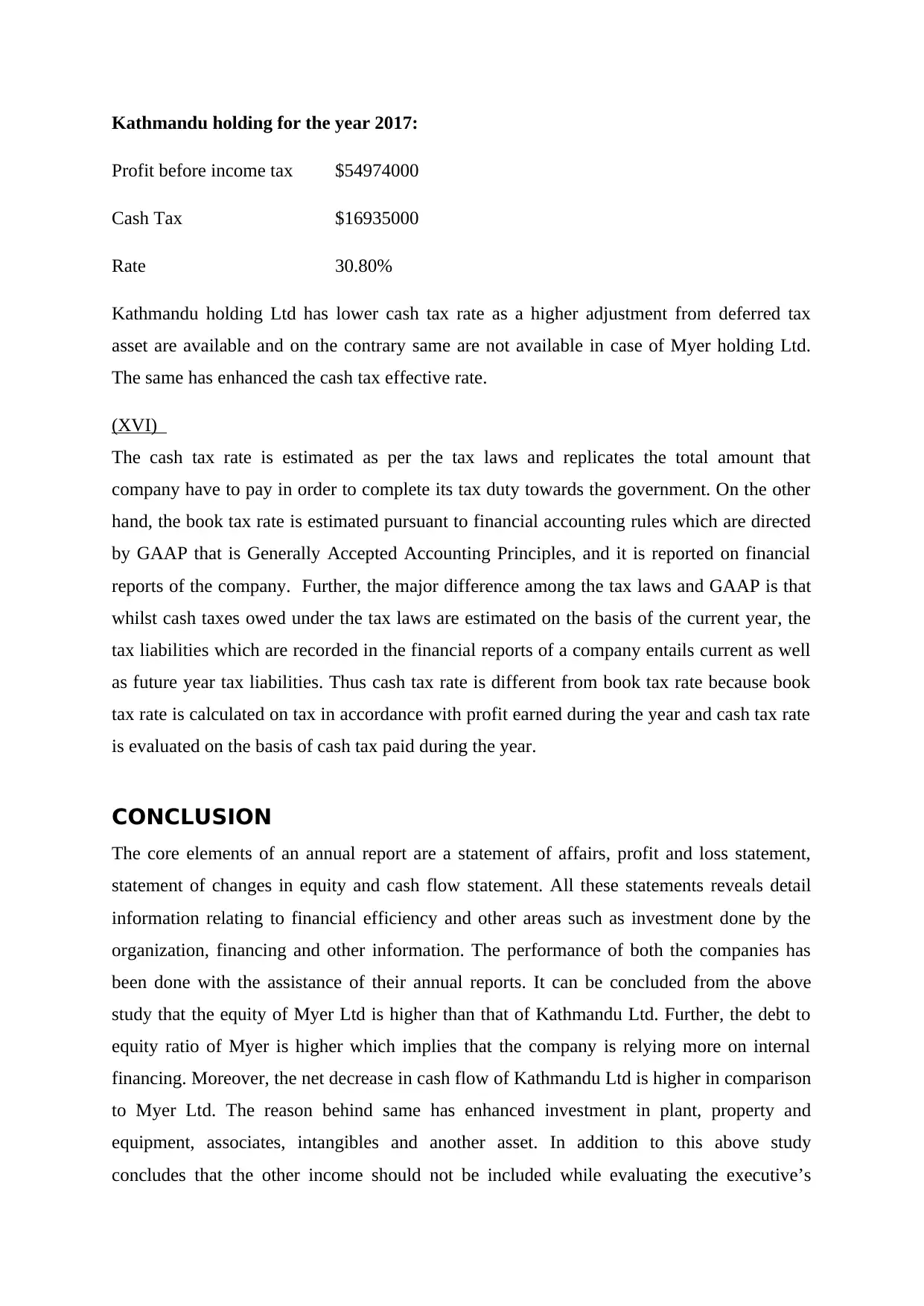
Kathmandu holding for the year 2017:
Profit before income tax $54974000
Cash Tax $16935000
Rate 30.80%
Kathmandu holding Ltd has lower cash tax rate as a higher adjustment from deferred tax
asset are available and on the contrary same are not available in case of Myer holding Ltd.
The same has enhanced the cash tax effective rate.
(XVI)
The cash tax rate is estimated as per the tax laws and replicates the total amount that
company have to pay in order to complete its tax duty towards the government. On the other
hand, the book tax rate is estimated pursuant to financial accounting rules which are directed
by GAAP that is Generally Accepted Accounting Principles, and it is reported on financial
reports of the company. Further, the major difference among the tax laws and GAAP is that
whilst cash taxes owed under the tax laws are estimated on the basis of the current year, the
tax liabilities which are recorded in the financial reports of a company entails current as well
as future year tax liabilities. Thus cash tax rate is different from book tax rate because book
tax rate is calculated on tax in accordance with profit earned during the year and cash tax rate
is evaluated on the basis of cash tax paid during the year.
CONCLUSION
The core elements of an annual report are a statement of affairs, profit and loss statement,
statement of changes in equity and cash flow statement. All these statements reveals detail
information relating to financial efficiency and other areas such as investment done by the
organization, financing and other information. The performance of both the companies has
been done with the assistance of their annual reports. It can be concluded from the above
study that the equity of Myer Ltd is higher than that of Kathmandu Ltd. Further, the debt to
equity ratio of Myer is higher which implies that the company is relying more on internal
financing. Moreover, the net decrease in cash flow of Kathmandu Ltd is higher in comparison
to Myer Ltd. The reason behind same has enhanced investment in plant, property and
equipment, associates, intangibles and another asset. In addition to this above study
concludes that the other income should not be included while evaluating the executive’s
Profit before income tax $54974000
Cash Tax $16935000
Rate 30.80%
Kathmandu holding Ltd has lower cash tax rate as a higher adjustment from deferred tax
asset are available and on the contrary same are not available in case of Myer holding Ltd.
The same has enhanced the cash tax effective rate.
(XVI)
The cash tax rate is estimated as per the tax laws and replicates the total amount that
company have to pay in order to complete its tax duty towards the government. On the other
hand, the book tax rate is estimated pursuant to financial accounting rules which are directed
by GAAP that is Generally Accepted Accounting Principles, and it is reported on financial
reports of the company. Further, the major difference among the tax laws and GAAP is that
whilst cash taxes owed under the tax laws are estimated on the basis of the current year, the
tax liabilities which are recorded in the financial reports of a company entails current as well
as future year tax liabilities. Thus cash tax rate is different from book tax rate because book
tax rate is calculated on tax in accordance with profit earned during the year and cash tax rate
is evaluated on the basis of cash tax paid during the year.
CONCLUSION
The core elements of an annual report are a statement of affairs, profit and loss statement,
statement of changes in equity and cash flow statement. All these statements reveals detail
information relating to financial efficiency and other areas such as investment done by the
organization, financing and other information. The performance of both the companies has
been done with the assistance of their annual reports. It can be concluded from the above
study that the equity of Myer Ltd is higher than that of Kathmandu Ltd. Further, the debt to
equity ratio of Myer is higher which implies that the company is relying more on internal
financing. Moreover, the net decrease in cash flow of Kathmandu Ltd is higher in comparison
to Myer Ltd. The reason behind same has enhanced investment in plant, property and
equipment, associates, intangibles and another asset. In addition to this above study
concludes that the other income should not be included while evaluating the executive’s
Secure Best Marks with AI Grader
Need help grading? Try our AI Grader for instant feedback on your assignments.
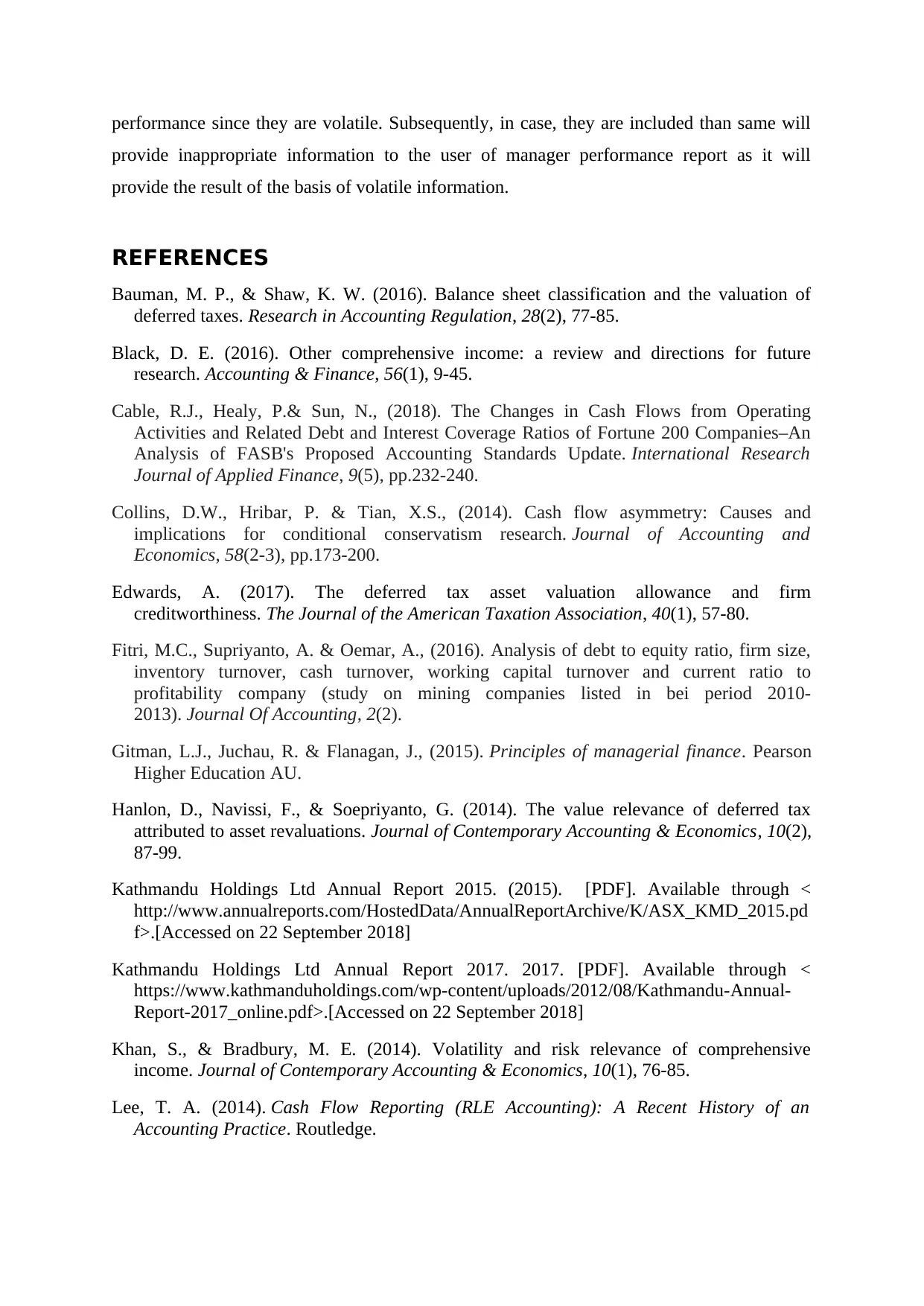
performance since they are volatile. Subsequently, in case, they are included than same will
provide inappropriate information to the user of manager performance report as it will
provide the result of the basis of volatile information.
REFERENCES
Bauman, M. P., & Shaw, K. W. (2016). Balance sheet classification and the valuation of
deferred taxes. Research in Accounting Regulation, 28(2), 77-85.
Black, D. E. (2016). Other comprehensive income: a review and directions for future
research. Accounting & Finance, 56(1), 9-45.
Cable, R.J., Healy, P.& Sun, N., (2018). The Changes in Cash Flows from Operating
Activities and Related Debt and Interest Coverage Ratios of Fortune 200 Companies–An
Analysis of FASB's Proposed Accounting Standards Update. International Research
Journal of Applied Finance, 9(5), pp.232-240.
Collins, D.W., Hribar, P. & Tian, X.S., (2014). Cash flow asymmetry: Causes and
implications for conditional conservatism research. Journal of Accounting and
Economics, 58(2-3), pp.173-200.
Edwards, A. (2017). The deferred tax asset valuation allowance and firm
creditworthiness. The Journal of the American Taxation Association, 40(1), 57-80.
Fitri, M.C., Supriyanto, A. & Oemar, A., (2016). Analysis of debt to equity ratio, firm size,
inventory turnover, cash turnover, working capital turnover and current ratio to
profitability company (study on mining companies listed in bei period 2010-
2013). Journal Of Accounting, 2(2).
Gitman, L.J., Juchau, R. & Flanagan, J., (2015). Principles of managerial finance. Pearson
Higher Education AU.
Hanlon, D., Navissi, F., & Soepriyanto, G. (2014). The value relevance of deferred tax
attributed to asset revaluations. Journal of Contemporary Accounting & Economics, 10(2),
87-99.
Kathmandu Holdings Ltd Annual Report 2015. (2015). [PDF]. Available through <
http://www.annualreports.com/HostedData/AnnualReportArchive/K/ASX_KMD_2015.pd
f>.[Accessed on 22 September 2018]
Kathmandu Holdings Ltd Annual Report 2017. 2017. [PDF]. Available through <
https://www.kathmanduholdings.com/wp-content/uploads/2012/08/Kathmandu-Annual-
Report-2017_online.pdf>.[Accessed on 22 September 2018]
Khan, S., & Bradbury, M. E. (2014). Volatility and risk relevance of comprehensive
income. Journal of Contemporary Accounting & Economics, 10(1), 76-85.
Lee, T. A. (2014). Cash Flow Reporting (RLE Accounting): A Recent History of an
Accounting Practice. Routledge.
provide inappropriate information to the user of manager performance report as it will
provide the result of the basis of volatile information.
REFERENCES
Bauman, M. P., & Shaw, K. W. (2016). Balance sheet classification and the valuation of
deferred taxes. Research in Accounting Regulation, 28(2), 77-85.
Black, D. E. (2016). Other comprehensive income: a review and directions for future
research. Accounting & Finance, 56(1), 9-45.
Cable, R.J., Healy, P.& Sun, N., (2018). The Changes in Cash Flows from Operating
Activities and Related Debt and Interest Coverage Ratios of Fortune 200 Companies–An
Analysis of FASB's Proposed Accounting Standards Update. International Research
Journal of Applied Finance, 9(5), pp.232-240.
Collins, D.W., Hribar, P. & Tian, X.S., (2014). Cash flow asymmetry: Causes and
implications for conditional conservatism research. Journal of Accounting and
Economics, 58(2-3), pp.173-200.
Edwards, A. (2017). The deferred tax asset valuation allowance and firm
creditworthiness. The Journal of the American Taxation Association, 40(1), 57-80.
Fitri, M.C., Supriyanto, A. & Oemar, A., (2016). Analysis of debt to equity ratio, firm size,
inventory turnover, cash turnover, working capital turnover and current ratio to
profitability company (study on mining companies listed in bei period 2010-
2013). Journal Of Accounting, 2(2).
Gitman, L.J., Juchau, R. & Flanagan, J., (2015). Principles of managerial finance. Pearson
Higher Education AU.
Hanlon, D., Navissi, F., & Soepriyanto, G. (2014). The value relevance of deferred tax
attributed to asset revaluations. Journal of Contemporary Accounting & Economics, 10(2),
87-99.
Kathmandu Holdings Ltd Annual Report 2015. (2015). [PDF]. Available through <
http://www.annualreports.com/HostedData/AnnualReportArchive/K/ASX_KMD_2015.pd
f>.[Accessed on 22 September 2018]
Kathmandu Holdings Ltd Annual Report 2017. 2017. [PDF]. Available through <
https://www.kathmanduholdings.com/wp-content/uploads/2012/08/Kathmandu-Annual-
Report-2017_online.pdf>.[Accessed on 22 September 2018]
Khan, S., & Bradbury, M. E. (2014). Volatility and risk relevance of comprehensive
income. Journal of Contemporary Accounting & Economics, 10(1), 76-85.
Lee, T. A. (2014). Cash Flow Reporting (RLE Accounting): A Recent History of an
Accounting Practice. Routledge.
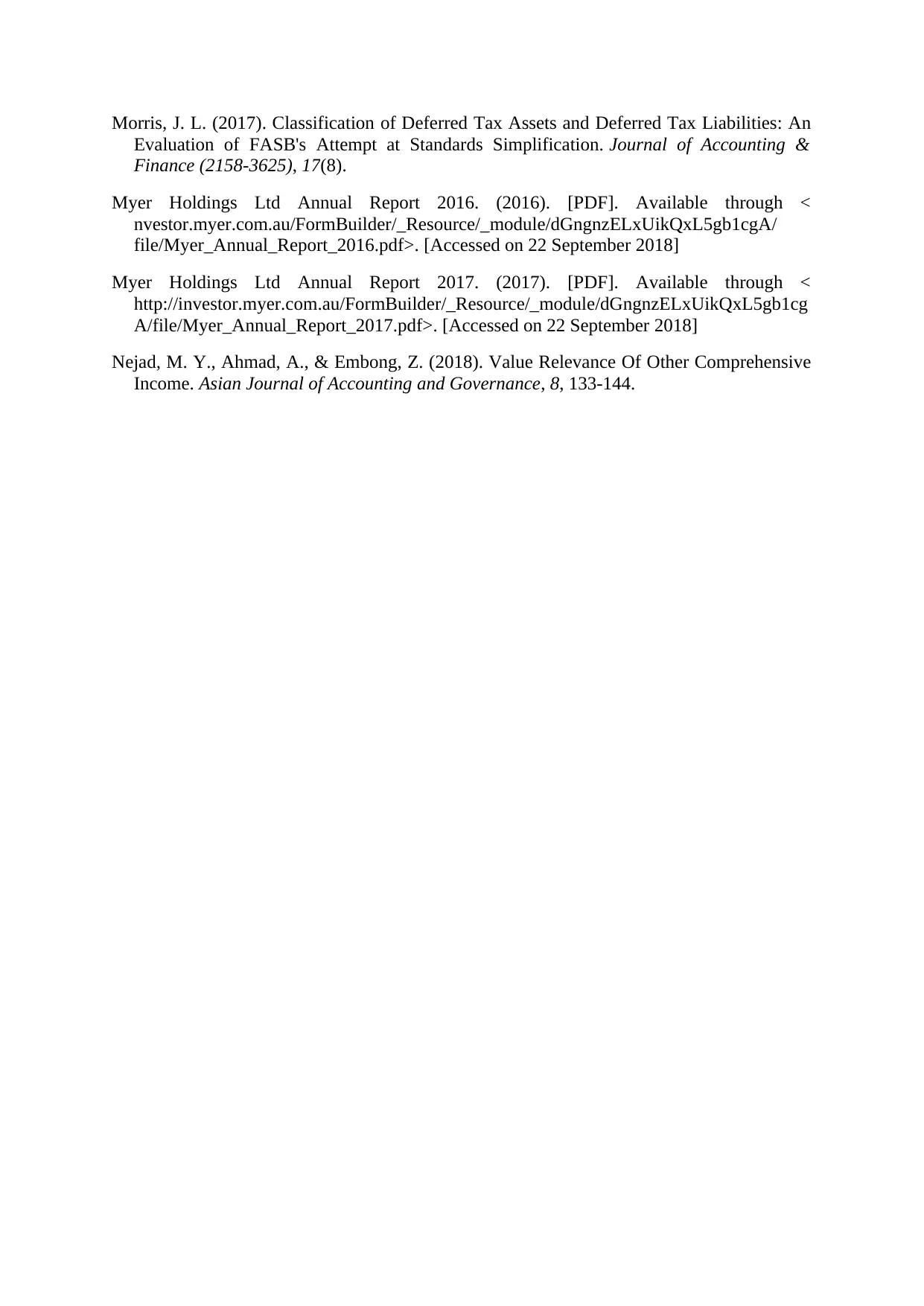
Morris, J. L. (2017). Classification of Deferred Tax Assets and Deferred Tax Liabilities: An
Evaluation of FASB's Attempt at Standards Simplification. Journal of Accounting &
Finance (2158-3625), 17(8).
Myer Holdings Ltd Annual Report 2016. (2016). [PDF]. Available through <
nvestor.myer.com.au/FormBuilder/_Resource/_module/dGngnzELxUikQxL5gb1cgA/
file/Myer_Annual_Report_2016.pdf>. [Accessed on 22 September 2018]
Myer Holdings Ltd Annual Report 2017. (2017). [PDF]. Available through <
http://investor.myer.com.au/FormBuilder/_Resource/_module/dGngnzELxUikQxL5gb1cg
A/file/Myer_Annual_Report_2017.pdf>. [Accessed on 22 September 2018]
Nejad, M. Y., Ahmad, A., & Embong, Z. (2018). Value Relevance Of Other Comprehensive
Income. Asian Journal of Accounting and Governance, 8, 133-144.
Evaluation of FASB's Attempt at Standards Simplification. Journal of Accounting &
Finance (2158-3625), 17(8).
Myer Holdings Ltd Annual Report 2016. (2016). [PDF]. Available through <
nvestor.myer.com.au/FormBuilder/_Resource/_module/dGngnzELxUikQxL5gb1cgA/
file/Myer_Annual_Report_2016.pdf>. [Accessed on 22 September 2018]
Myer Holdings Ltd Annual Report 2017. (2017). [PDF]. Available through <
http://investor.myer.com.au/FormBuilder/_Resource/_module/dGngnzELxUikQxL5gb1cg
A/file/Myer_Annual_Report_2017.pdf>. [Accessed on 22 September 2018]
Nejad, M. Y., Ahmad, A., & Embong, Z. (2018). Value Relevance Of Other Comprehensive
Income. Asian Journal of Accounting and Governance, 8, 133-144.
1 out of 18
Related Documents
Your All-in-One AI-Powered Toolkit for Academic Success.
+13062052269
info@desklib.com
Available 24*7 on WhatsApp / Email
![[object Object]](/_next/static/media/star-bottom.7253800d.svg)
Unlock your academic potential
© 2024 | Zucol Services PVT LTD | All rights reserved.



